

Amazing World Cruises
A World of Endless Travel Possibilities.
- Glamorous Gustavia 2024 Seven Seas Navigator December 13-23, 2024
- Colorful Caribbean Shores Seven Seas Grandeur March 5-19, 2025
- Play My Cruise
- Cruise Preferences Tell us about your cruise preferences and we’ll recommend the perfect voyage for you.
- Africa Cruises
- Alaska Cruises
- Antarctica Cruises
- Arabian Gulf Cruises
- Asia Pacific Cruises
- Australia Cruises
- Bahamas Cruises
- Canada Cruises
- Caribbean Cruises
- Central America Cruises
- Eastern Europe Cruises
- Galapagos Cruises
- Hawaii Cruises
- Japan Cruises
- Mediterranean Cruises
- Mexican Riviera Cruises
- Northern Europe Cruises
- Panama Canal Cruises
- Repositioning Cruises
- South Pacific Cruises
- Transatlantic Cruises
- World Cruises
- Meet Our Agents
- 2024 World Cruises
- 2025 World Cruises
- 2025 Cunard Queen Anne World Cruise
- 2026 World Cruises
- Travel Blog
Aircraft Carrier vs Cruise Ship: Giant Size Comparison

Book Your Next Amazing Cruise with Travel Leader, Jeffrey Cleary
People have always been fascinated by gigantic ships. From history’s largest battleships to iconic passenger vessels, like the RMS Titanic , nothing captures the imagination quite like a sea-faring giant. That’s why we’re stacking up an aircraft carrier vs cruise ship and seeing how these vessels roam our seas.
Although they serve entirely different purposes, these two ships stand out as some of the largest and most intriguing. This guide will take a deep dive into comparing aircraft carriers and modern cruise ships so you can discover that they can actually be roughly the same size!
We’ll even explore how the world’s current largest aircraft carrier, the Gerald R. Ford Class Aircraft Carrier, is only 92 feet shorter than the largest cruise ship, Royal Caribbean’s Icon of the Seas .
Beyond offering a detailed size comparison, this comprehensive guide will also uncover differences in the purposes, maneuverability, and environmental impacts of these two types of ships.
So, if you’re ready to learn more about these ocean giants, let’s get started!
How Does a Cruise Ship Compare to an Aircraft Carrier?
The average gross tonnage of a cruise ship is 150,000, along with an average length of 1,100 feet and 180 feet high. A typical aircraft carrier would be at 90,000 tonnes, 1,000 feet in length and 242 feet high. An aircraft carrier can often be much larger than a medium-sized cruise ship.
Aircraft Carriers
The concept of an aircraft carrier was first thought up during the First World War, as air power had demonstrated its significance in warfare. While early aircraft-carrying vessels developed by the British Royal Navy during this time failed to impress, these early aircraft carriers laid the foundations for the development of today’s enormous floating runway ships.

By the Second World War, the aircraft carrier had emerged as an essential weapon in naval warfare. Even outside of war, they serve as a stark projection of a nation’s military might. With missions ranging from combat to humanitarian assistance and disaster relief, today’s enormous and cutting-edge aircraft carriers hardly resemble the humble carriers of the early 20th century, like the HMS Furious .
Cruise Ships
Like aircraft carriers, cruise ships emerged in the early 20th century. While luxury ocean liners and ferries already existed, their primary purpose was transportation. The concept of a large-scale passenger ship explicitly designed for leisure and pleasure cruising was pretty new.
The first modern cruise ship, the Prinzessin Victoria Luise, was launched in 1900 , and it featured luxury accommodations and amenities, as well as leisurely voyages to exotic locations.
Today, cruise ships have grown in size and complexity to the point that they have almost evolved into floating resorts. By the 1960s, a growing tourism market meant the idea of relaxing on a luxury cruise ship had fully entered popular culture. Today, the cruise industry generates over $150 billion in economic activity and involves numerous cruise lines.
Aircraft Carrier vs Cruise Ship Size Comparison
As mentioned, cruise ships and aircraft carriers may serve completely different roles and have distinct backgrounds, but they are fairly similar in physical size. To illustrate this point, we have provided a simple chart that compares the world’s largest cruise ship and the world’s largest aircraft carrier, as well as more general size comparisons of average vessels in each class:
As you can see from a comparison of the current record holders for size, cruise ships tend to be longer than aircraft carriers, while the latter tends to be wider. An aircraft carrier’s added width and depth is due to accommodate and store aircraft. Due to tailhook technology, aircraft carriers do not need overly long flight decks , but the width helps with emergency landings and organizing aircraft before takeoff.

On the other hand, cruise ships are far denser, which explains the added weight. Since their many decks are packed with passenger cabins and suites, heavy amenities like swimming pools and restaurants, and so much more, their gross tonnage can be substantial. Plus, their added length, which helps them fit more into a streamlined ship, also contributes to their weight.
Simply put, aircraft carriers tend to be wider and taller than cruise ships, but cruise ships are usually heavier and longer.
Construction and Cost Differences
Given that both types of ships are incredibly large and complex, it is no surprise that construction takes years. The following is a basic breakdown of the differences in the processes:
Construction typically takes between two and three years. The design and planning phase involves a collaboration between the cruise lines, naval architects, and shipyard engineers. Conceptualizing the ship’s specifications, layout, and types of amenities it will be outfitted with is an incredibly complex process.
Read Also: How Long Does It Take to Build a Cruise Ship?
Once a design has been finalized, the hull is assembled using enormous prefabricated steel plates. This occurs in a dry dock. From there, the ship’s interior can be outfitted with everything from passenger cabins to restaurants and recreational facilities. The vessel must also have the latest navigational systems, massive propulsion systems, fuel tanks, and a heavy cruise ship anchor.
Unlike cargo ships and other less complex vessels, the ships also need reliable HVAC systems for customer comfort and large-scale electrical systems capable of handling the ship’s immense power demands.
Once everything has been installed and the ship is fully furnished, rigorous sea trials are conducted to test the ship’s performance, safety, and compliance with maritime regulations .
While cruise ships vary in cost according to their size and what amenities are included in their design, most cost just shy of $1 billion to build. With that said, the world’s largest and most expensive cruise ship, the Icon of the Seas, cost Royal Caribbean International an estimated $2 billion!
Due to their complexity, aircraft carriers take longer to build. For most, the entire process spans 5 to 7 years, with each ship having unique demands according to its operational requirements.
Not only do these ships need to be outfitted with incredibly complex systems, but the entire process involves a shroud of secrecy, as these ships are incredibly valuable pieces of military hardware.
The process starts with the laying of the keel. From there, the high-strength steel alloy hull is attached. The hulls must be capable of withstanding the hardships of ocean travel and extreme weather, and they also need to be engineered to withstand the demands of a potential combat situation.

Once the outer structure of the ship has been completed, a vast array of complex systems, like aircraft elevators, recovery systems, firefighting systems, defensive armaments, and navigation equipment, must be installed and tested. On top of that, the enormous flight decks that are such an iconic feature of an aircraft carrier also have to be built.
The same is true for the internal hangars for the various types of aircraft the ship will carry, crew quarters, and the countless other needs of a ship that needs to be ready for both aerial and naval combat.

On top of all that, modern aircraft carriers are even powered by nuclear reactors , so they can stay operational indefinitely. As you can imagine, building a nuclear-powered ship is incredibly time-consuming and demanding. Finally, before the ship can be deemed ready for service, it must be thoroughly tested.
Unsurprisingly, all of this complexity comes with an eye-watering price tag. Most of the latest classes of aircraft carriers, like the Nimitz-Class carriers operated by the United States, cost over $6 billion to build.
Differences in Purpose and Function
As we discussed earlier, the two types of vessels serve entirely different purposes. Where an aircraft carrier’s main job is to be a significant source of naval power by being able to act as a floating airfield and mobile base, cruise ships are designed with the passenger experience as the top priority.

While aircraft carriers can certainly act as hugely significant weapons of war and as combat command centers, they also work as war deterrents. Demonstrating a nation’s naval and air superiority in the world’s most highly contested waters discourages hostile nations from attacking others. They can also serve a valuable purpose during humanitarian missions by delivering aid and evacuation aircraft worldwide.
On the other hand, cruise ships enable passengers to experience the adventure and relaxation of a floating paradise that can travel to the most incredible destinations. While they have many of the same features that make a resort vacation so enjoyable, they are mobile, so passengers can visit ports around the world and take in the natural beauty of the world’s coastlines, oceans, and seas.
Facilities, Amenities, and Systems
Cruise ship facilities and amenities differ according to the specific design of the ship, but most feature numerous restaurants and bars, theaters for live performances and entertainment, casinos, swimming pools and water parks, lounge decks, spas, gyms, and more.
Cruise ships have a wide range of comfortable facilities, entertaining amenities, and luxury accommodations, so their guests can enjoy the unique blend of adventure, fun, and relaxation that is unique to the cruise industry.
Aircraft carriers feature a wide array of offensive and defensive systems and all the facilities required to house their enormous crews. They must also function as floating runways for military aircraft, including fighter jets and helicopters.

On top of military systems and hardware, like missile defense systems, these floating bases also need medical bays, crew quarters, mess halls, gyms, laundry facilities, and storage areas. Think of an aircraft carrier as a mixture of a floating military base, an air force airfield, and a naval vessel.
Number of Passengers and Crew
Aircraft carriers usually carry a complement of over 5,000 individuals. This number includes sailors, naval officers, pilots, and countless support personnel responsible for maintaining the ship and the complex systems and aircraft it carries. On top of that, you have engineers, navigators, doctors, cooks, and more.

On the other hand, the passenger capacity of cruise ships sits at an average of about 3,000 passengers. The average ship will also travel with a crew of nearly 1,000 people. That said, the number can fluctuate depending on the size of the ship. Take, for example, the Icon of the Seas , which was designed to hold 5,610 passengers and a crew of 2,350 .
Fuel Source, Top Speed, and Maneuverability
Modern aircraft carriers are powered by nuclear reactors that can propel their powerful engines at a speed exceeding 30 knots (roughly 55.5 km per hour). On top of that, these enormous ships are also incredibly agile, as they need to be able to pivot direction and respond quickly to threats and new orders.
On the other hand, cruise ships rely on diesel-electric propulsion systems. A cruise ship’s top speed is generally 18 to 22 knots . Since these vessels were designed for passenger comfort rather than military action and rapid transit, they move at a slower and more consistent pace.
Their propulsion systems are also designed to maximize fuel efficiency, as this reduces operating costs, environmental impact, and the amount of diesel fuel they need to carry.
Environmental Impacts
Since aircraft carriers use nuclear reactors that generate steam to drive their turbines, they emit less emissions than you get with fossil fuel-powered ships. Although reducing greenhouse emissions was not the intention, it is a major plus, given these huge ships travel enormous distances and stay at sea for months at a time.

On the other hand, the diesel engines used by cruise ships need to burn a significant amount of fuel as a power source for their propulsion and electrical systems. This does contribute heavily to air pollution, but the cruise industry is working to improve its environmental image by introducing more fuel-efficient ships, and other tactics, like using onboard waste reduction and recycling systems.
Safety and Security Measures
Since aircraft carriers are military vessels, they face extreme security challenges. Defensive systems, like anti-aircraft missiles and close-in weapons gun systems , help protect the ship from aerial threats. Sprinkler systems and firefighting crews also help reduce the threat of fires.

Traditional safety measures are also used to protect the crew, including adequate lifeboats for all personnel and incredibly complex navigation and communications systems.
Worth Reading: What to Expect During a Cruise Ship Muster Drill
Cruise ships are outfitted with fire suppression systems, CCTV systems, complex weather detection and communications systems, and lifeboats to keep their guests and crew safe. Plus, the entire crew and security staff are trained to follow the safety procedures needed to keep everyone safe in any situation.
Typical Routes
When it comes to aircraft carrier vs cruise ship, both types of ships traverse waters around the world, but aircraft carriers tend to prioritize strategic choke points and high-traffic waterways. This allows them to contribute to global stability and react to various situations around the globe.

On the other hand, cruise ships usually have itineraries that take them to areas with a booming tourism sector, like the Caribbean and Mediterranean, as well as places with picturesque natural beauty, like Alaska. With that said, cruise lines are operating all over the world, each offering unique itineraries that visit exciting destinations and offer memorable excursions.
Frequently Asked Questions (FAQs)
Which is bigger, an oil tanker or an aircraft carrier.
As the world’s largest ships, typical oil tankers tend to be bigger than aircraft carriers in terms of length and width. They also weigh more, especially when fully loaded with their liquid cargo. Take, for example, the largest ship ever built, a super oil tanker called the Seawise Giant. It measured over 1,500 feet in length!
Which is bigger, a container ship or an aircraft carrier?
A container ship is usually bigger than an aircraft carrier, as they are built to be as large as possible to carry cargo across the world’s oceans and largest seas.
What is so special about an aircraft carrier?
Aircraft carriers are one of the most important symbols of power and tools of military might in a nation’s arsenal. These mobile air bases can react to threats worldwide while safeguarding the world’s oceans.

Caribbean Cruises | Carnival Caribbean Cruises | Celebrity Caribbean Cruises | Cunard Caribbean Cruises | Disney Caribbean Cruises | Holland America Caribbean Cruises | MSC Caribbean Cruises | Norwegian Caribbean Cruises | Oceania Caribbean Cruises | Princess Caribbean Cruises | Regent Seven Seas Caribbean Cruises | Seabourn Caribbean Cruises
World Cruise | 2024 Queen Mary 2 World Cruise | 2024 MSC Poesia World Cruise | 2025 Around the World Cruise | Amazing World Cruises | Luxury Cruising | Home
Recommended Posts

Royal Caribbean to Make Wishes Come True With New Partnership

Cruise Ship Encounters Red Sea Tensions on Repositioning Voyage

Atlantic Canada Set for Another Record Cruise Season in 2024

Cruise Port’s New Management to Invest £25 Million

Carnival Cruise Line Increases Price on Popular Item for Third Time

Cruises for Snorkelers: The 6 Best Snorkeling Destinations in the World
Jeffrey Cleary is an experienced travel advisor and cruise specialist with a wealth of knowledge and expertise in Caribbean and World cruises. With over a decade of experience in the travel industry, Jeffrey has developed a reputation as a trusted advisor for those seeking unforgettable Caribbean and/or World cruise experiences. "I bring a wealth of experience and knowledge in the cruise industry, along with real-world experience on many of the finest ships at sea. I love cruising myself, so I am often sailing (and reachable by clients) and experiencing the cruise lines first hand. I'll get to know you, your style, your ideal vacation and recommend an Amazing Cruise experience."

- Military Time
- Military Discounts
- Squadron Spotlight
- Tactical Tech
- First Responders
Select Page
Aircraft Carrier vs Cruise Ship: Comparing Ocean Giants
Posted by theblitzcorp.com | Aug 24, 2023 | Informational | 0 |
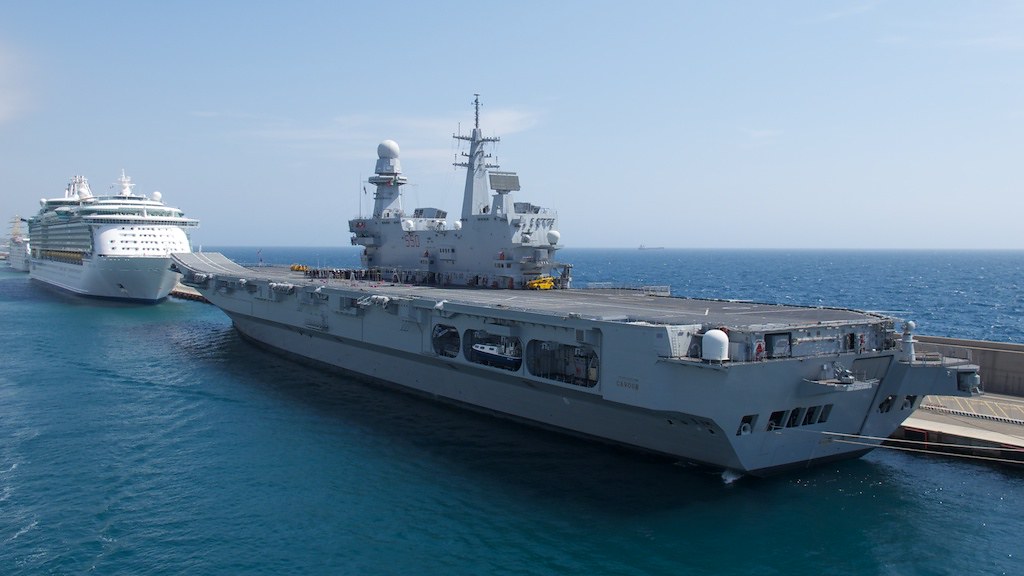
The aircraft carrier vs cruise ship question comes up more than one would think. Aircraft carriers and cruise ships stand out when it comes to magnificent engineering marvels that rule the broad seas. Both are enormous in size and weigh a great deal, but they have very distinct functions. We shall contrast aircraft carriers with cruise ships in this article to examine the key differences between them in terms of size, function, construction, accommodations, power source, duty, and safety.
Aircraft Carrier vs Cruise Ship Key Takeaways
- Aircraft carriers and cruise ships are both large vessels, but serve vastly different purposes.
- Aircraft carriers are designed for military use, while cruise ships are used for commercial tourism.
- Aircraft carriers are often larger and more heavily armed, while cruise ships prioritize passenger experience and entertainment.
- Each vessel has unique construction and design features, power sources and propulsion systems, and safety and security measures implemented.
- The economic impact and role of tourism associated with each vessel also differ.
Key Differences in Vessel Size Dimension and Purpose
Cruise ships and aircraft carriers are both ocean giants, though they serve different purposes and have very different sizes. An aircraft carrier's main job is to act as a mobile base for military aircraft such fighter jets and helicopters . In contrast, a cruise ship is built for pleasure and offers travelers a floating hotel experience.
Massive boats, aircraft carriers are typically 800-1000 feet long and over 100,000 tons in weight. Extreme weather, tremendous speeds, and the impact of aircraft takeoffs and landings are all things they are designed to withstand. The passenger capacity of cruise ships, on the other hand, is typically higher than that of aircraft carriers, with a normal length of 1000–1200 feet and a weight of 100,000–220,000 tons.
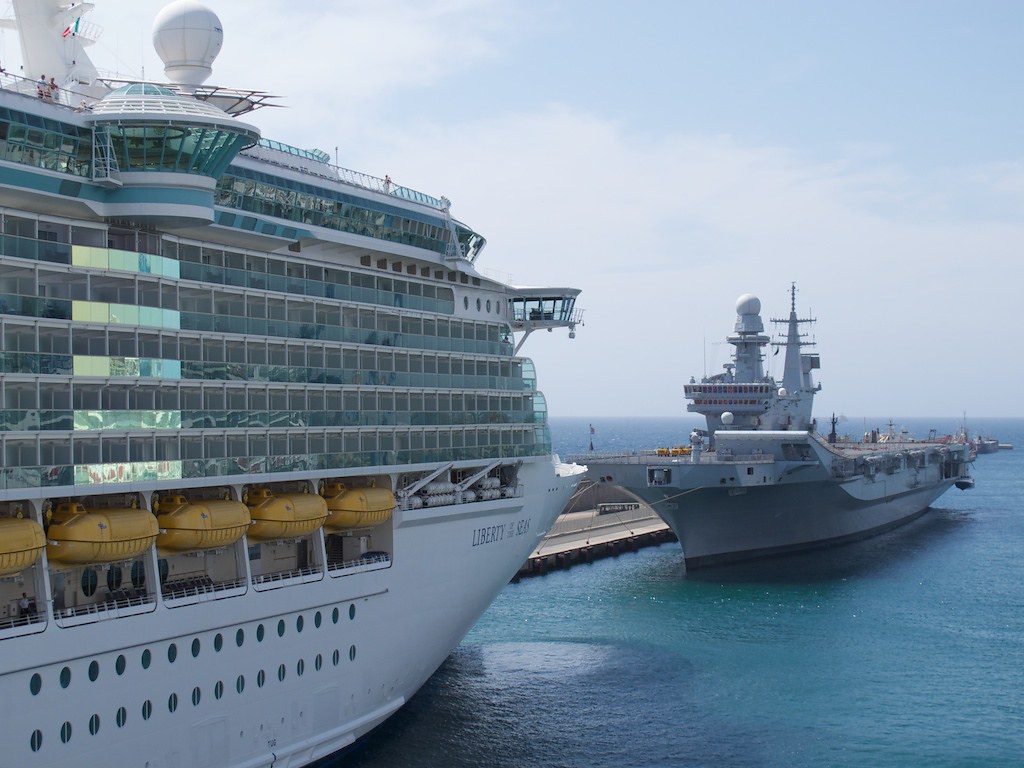
Both types of vessels exhibit some similarities in their layout and features, while being made for quite distinct reasons. For instance, both ships include various decks, dining rooms, and entertainment facilities to keep passengers and crew happy and comfortable.
Key Differences in Size and Purpose:
Construction and design features.
The structure and features of cruise ships and aircraft carriers are very different. Although both ships are built to survive the hardships of ocean travel, their respective missions and operating needs necessitate special design elements.
Fighter jets, helicopters, and other types of aircraft can be launched from and recovered by aircraft carriers, which are vessels designed expressly for naval combat. As a result, they have enormous flight decks for operating aircraft and are made to fit big air squadrons.
Did you know: The flight deck of a typical navy aircraft carrier is designed with a special heat-resistant coating to withstand the extreme temperatures generated by jet engines during takeoffs and landings?
Contrarily, cruise ships are recreational craft designed for the comfort and enjoyment of passengers. As a result, they give priority to features like restaurants, spas, theaters, and swimming pools. Additionally, specific design components for stability and agility, including bow thrusters and stabilizers, are needed for cruise ships.
Another notable difference is in their shape - aircraft carriers have a flat, streamlined deck with no protruding features to minimize wind resistance and maximize speed, while cruise ships are characterized by their towering, vertical superstructures that house passenger cabins and facilities.
Materials and Structural Integrity
To endure the enormous strains of ocean travel, both aircraft carriers and cruise ships are built with cutting-edge engineering and high-strength materials. In order to restrict the spread of damage in the case of an assault or accident, aircraft carriers are constructed with reinforced steel hulls and compartments. This is because aircraft carriers, in particular, are subjected to enormous loads and impact forces that might harm the ship's structural integrity.
Advanced materials like steel and aluminum are also used in the construction of cruise ships, although passenger safety and comfort are given priority. To assure passenger safety at all times, cruise ships, for instance, include cutting-edge navigational systems, fire suppression and detection systems, and emergency response protocols.
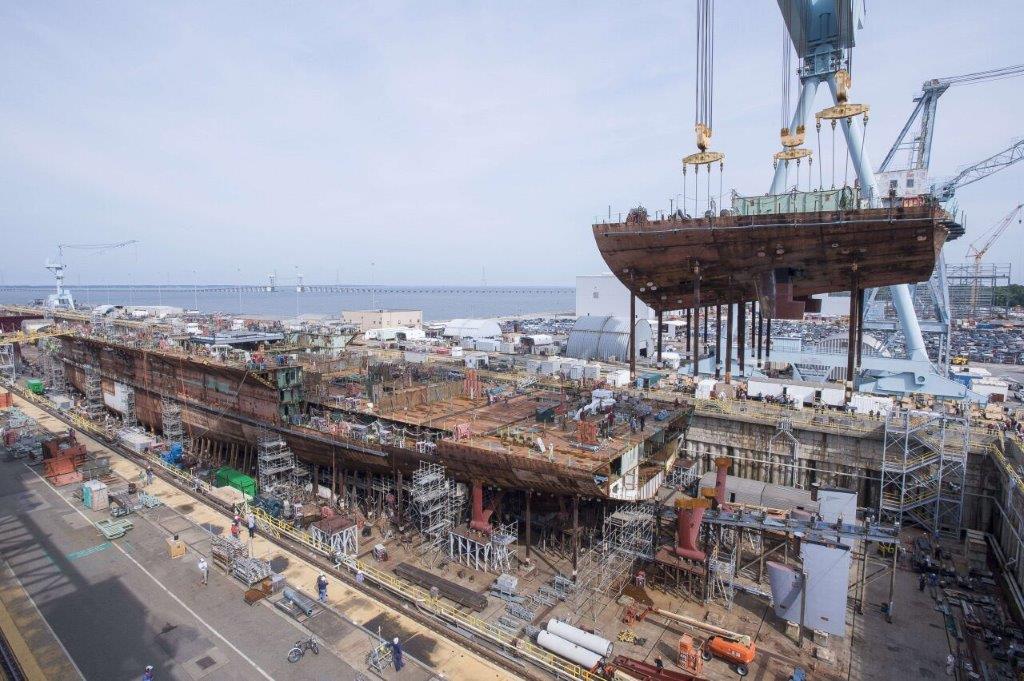
"An aircraft carrier is not built, it is grown." Admiral Hyman Rickover, father of the nuclear navy
In the end, the construction and design elements of aircraft carriers and cruise ships are different, reflecting the special functions and operational demands of each. While both boats are works of modern engineering, their designs and construction materials give priority to distinct aspects of ocean travel, with cruise liners focusing on passenger comfort and safety and aircraft carriers on military combat.
Accommodation Capacity and Passenger Experience
The ability of aircraft carriers and cruise ships to carry passengers is one of the most important distinctions. With little room and few amenities for passengers, aircraft carriers are primarily built to act as mobile airfields for military operations. Cruise ships, in contrast, are designed for comfort and relaxation, giving its guests a pleasant trip.
While cruise ships offer opulent cabins with all the conveniences of a five-star hotel, aircraft carriers have barracks-style lodging. On a cruise ship, passengers may often enjoy fine meals, entertainment options, and a variety of leisure pursuits including spas and swimming pools.
Aircraft carriers have a finite amount of room since they need to accommodate both military people and aircraft. For instance, the USS Gerald R. Ford can carry nearly 4,500 crew members but can only fit a few hundred more passengers. Modern cruise ships, like the Oasis-class ships from Royal Caribbean, may carry nearly 5,000 guests in addition to the crew.
Overall, while aircraft carriers and cruise ships share similarities in their oceanic capabilities, the different purposes of each vessel result in vastly different accommodation capacities and passenger experiences.
Power Source and Propulsion Systems
Power sources and propulsion systems aboard aircraft carriers and cruise ships are very different. Nuclear reactors are used to power aircraft carriers while diesel engines are often used on cruise ships. The aircraft carriers can run for extended periods of time without refueling because to the nuclear reactors' nearly limitless power supply. In contrast, cruise ship diesel engines need constant fueling and maintenance to operate at their best.
On an aircraft carrier nuclear reactors power the steam turbines and propellers used by aircraft carriers. Azipods, which are electrically propelled pods with 360-degree rotation, are used by cruise ships instead of propellers to provide more mobility. Azipods also offer the benefit of lowering noise and vibration levels, giving passengers a calmer and more comfortable journey.
Depending on their intended usage, cruise ships and aircraft carriers require different types of electricity and propulsion. The nuclear reactors on aircraft carriers give them the power they need to run and support the aircraft that are on board. Engines that are dependable, fuel-efficient, and capable of giving passengers a comfortable experience are needed for cruise ships. Both kinds of boats, however, need regular upkeep and attention to ensure their functionality and safety.
While nuclear reactors are more expensive to build and maintain than conventional engines, they offer several advantages, including long-range capability, silent operation, and reduced emissions. Cruise ships are increasingly using hybrid propulsion systems that combine diesel engines with electric motors. This can help to improve fuel efficiency and reduce emissions.
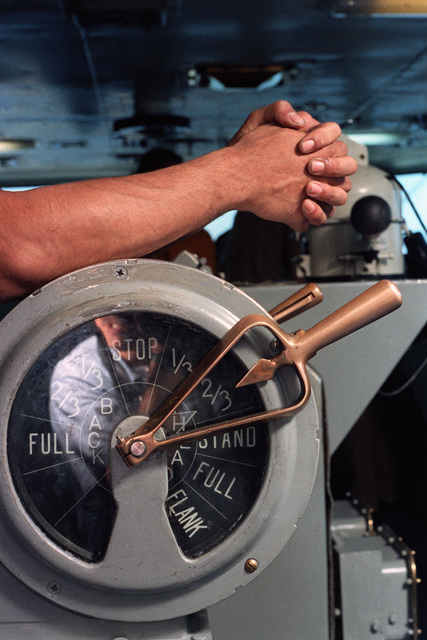
Role in the Navy and Commercial Sectors
In the military and private sectors, aircraft carriers and cruise ships play quite distinct roles. Aircraft carriers, the biggest and most potent warships in naval fleets, are built to support a variety of activities and act as mobile bases for military aircraft. They are able to project force across the oceans because they can carry a large number of fighter jets, helicopters , and other aircraft.
However, cruise ships are mostly employed for business-related activities like travel and tourism. They offer a wide range of services, including restaurants, entertainment venues, and recreational facilities, and are designed to carry thousands of passengers.
While national governments own and manage aircraft carriers, private firms typically own and manage cruise liners, which are part of the global tourist industry.
The Role of Aircraft Carriers in the Military
Modern warfare relies heavily on aircraft carriers to project naval force and assist military operations in the air. They are employed in a range of tasks, such as military operations, peacekeeping duties, and humanitarian aid initiatives.
Aircraft carriers can support surface ships and ground forces during combat operations by unleashing airstrikes against hostile targets and fending off approaching dangers. Additionally, they function as command and control hubs for coordinating military actions over great distances.
Aircraft carriers can be employed for a number of tasks in times of peace, such as humanitarian aid operations and international displays of force. Additionally, they convey military might and showcase a country's naval prowess as a deterrent to potential foes.
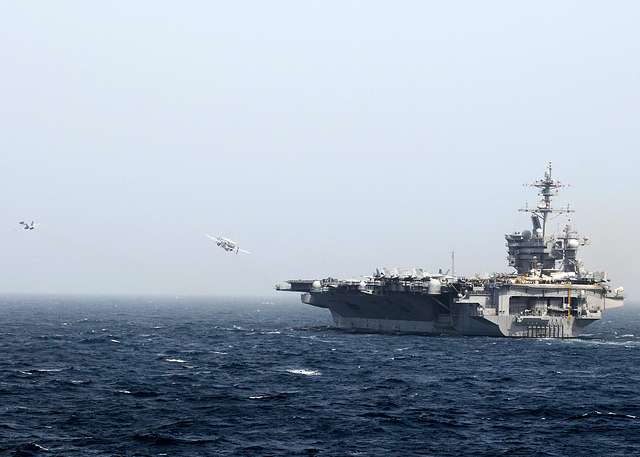
The Role of Cruise Ships in the Commercial Sector
Cruise ships transport passengers across the oceans of the world and offer a variety of amenities and entertainment alternatives. They are largely utilized for commercial purposes. They are owned and run by private businesses in the global tourism sector and bring in billions of dollars annually.
From exquisite dining and nightlife to onboard shopping and leisure activities, cruise ships provide a variety of activities and attractions. Additionally, many cruise ships include shore excursions so that travelers can experience well-known cities and tourist hotspots all around the world.
Additionally, cruise ships are a significant employer, giving thousands of people jobs in a variety of sectors, including hospitality, entertainment, and transportation.
Notable Examples of Bigger Aircraft Carriers and Cruise Ships
Both aircraft carriers and cruise ships have their fair share of impressive vessels. Here are some notable examples:
The USS Gerald R. Ford is the most expensive and most technologically advanced aircraft carrier ever built, while the INS Vikrant will be the first aircraft carrier built in India. The Admiral Kuznetsovi s a steam-powered aircraft carrier and is Russia's only aircraft carrier and was recently involved in a fire while undergoing repairs . The Admiral Kuznetsov is the oldest aircraft carrier still deployed and in service.
Also interesting is Japan's JS Kaga (DDH-184), which is a helicopter carrier being converted into an aircraft carrier since beginning in March 2022. The ship is the second of the Izumo class, and is similar in size to the USS Gerald R. Ford. However, it is not nuclear-powered, and will be able to carry up to 28 aircraft, including the F-35B Joint Strike Fighter. The conversion of the JS Kaga is a significant development , as it marks the first time that Japan has converted a helicopter carrier into an aircraft carrier since World War II.
On the cruise ship side, Royal Caribbean International's Oasis of the Seas was the world's largest cruise ship when it debuted in 2009. Cunard Line's Queen Mary 2 is famous for its transatlantic crossings and luxury amenities. Royal Caribbean International's Harmony of the Seas is the world's largest cruise ship by passenger capacity.
Performance and Speed at Sea
The performance and speed capabilities of aircraft carriers and cruise ships are very dissimilar. While aircraft carriers are constructed for speed and agility to efficiently carry out military missions, cruise ships are built for leisurely vacation.
A cruise ship's top speed is 22–24 knots (41–44 km/h), but an aircraft carrier can typically go at 30-35 knots (55–65 km/h). Due to their different purposes, cruise ships prioritize luxury over speed, whereas aircraft carriers must be able to move swiftly to defend against potential attacks.
As previously stated, performance-wise, aircraft carriers are equipped with highly sophisticated propulsion systems, such as nuclear reactors, steam turbines, and gas turbines, that enable them to maintain high speeds for prolonged periods of time without refueling. On the other hand, cruise ships generally use diesel-powered engines.
The USS Gerald R. Ford, the newest aircraft carrier in the US Navy, is a great illustration of a ship with outstanding performance and speed capabilities. With two nuclear reactors, it has an operating lifespan of more than 20 years without refueling and a top speed of more than 30 knots (56 km/h).
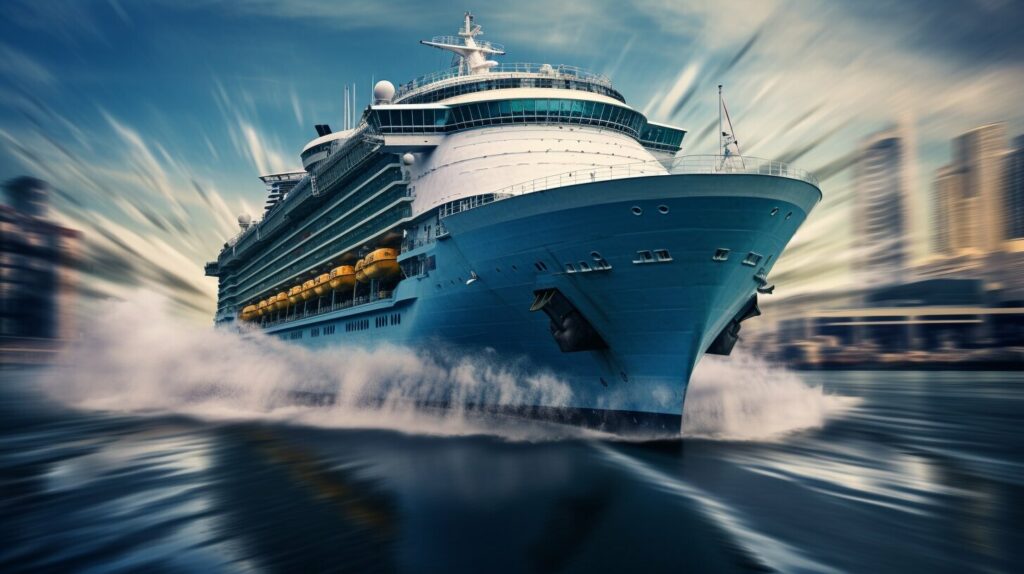
While both cruise ships and aircraft carriers have distinct benefits and capabilities, there are substantial disparities in their performance and speed that are a reflection of their contrasting roles in military and commercial travel.
Economic Impact and Tourism
The economies of the nations and ports that aircraft carriers and cruise ships visit are significantly impacted by their size and scope. Although aircraft carriers are primarily used for military purposes, the crew and support staff that travel with them can have an impact on the local economy.
On the other hand, cruise ships directly affect the regional economies of the ports they visit. According to a survey by the Cruise Lines International Association, the cruise industry had a $154 billion global economic impact in 2018 and supported more than 1.17 million employment throughout the globe.
Additionally, both cruise ships and aircraft carriers are crucial to the tourism sector. These enormous ships are frequently visited and explored by tourists, which enhances the whole tourism experience. In reality, a few cruise lines provide excursions that feature visits to retired aircraft carriers.
However, the COVID-19 pandemic has had an effect on the tourism sector, with numerous nations barring their ports to cruise liners. With cruise companies establishing tight health and safety procedures, the sector is gradually rebounding. However, it is impossible to overstate the economic contribution and significance of both cruise ships and aircraft carriers to the travel and tourism sector.
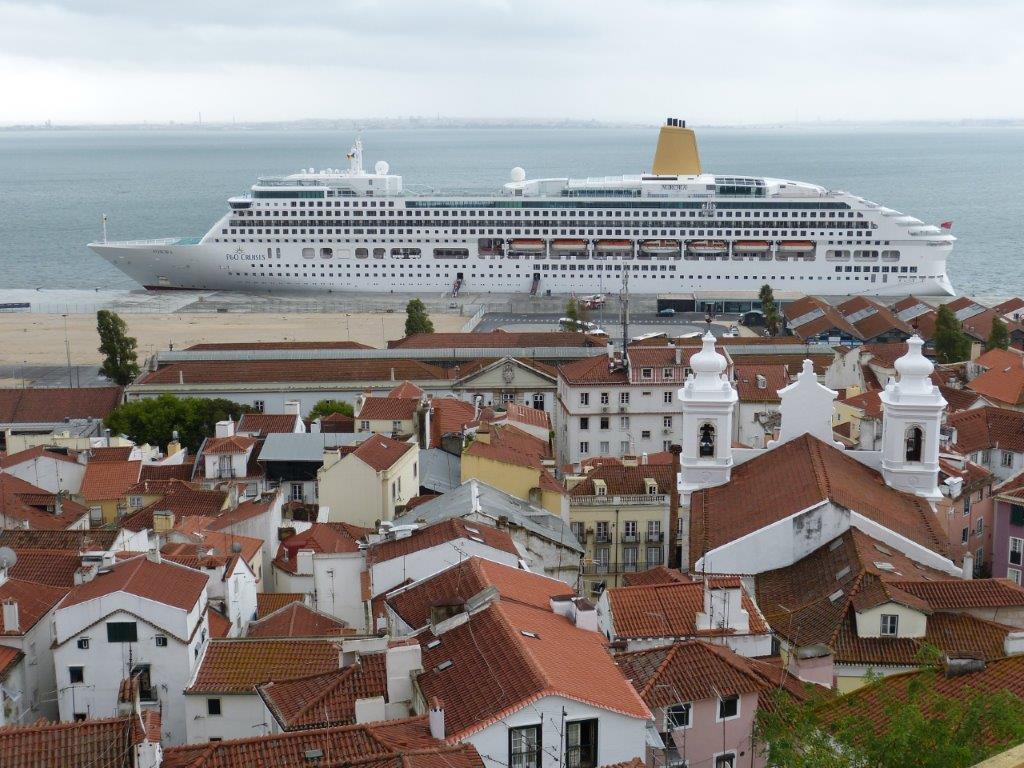
"The cruise industry is a vital part of the American economy. It generates billions of dollars in revenue and supports hundreds of thousands of jobs." - Cruise Lines International Association
Safety and Security Measures
To protect the well being of their passengers and crew, aircraft carriers and cruise ships both undertake strict safety and security procedures.
Due to the risky nature of military operations, safety protocols are given considerable importance on aircraft carriers. These boats have cutting-edge fire suppression systems, emergency evacuation strategies, and sophisticated radar systems to spot possible threats. The crew members also receive comprehensive training in safety practices, such as first aid, damage management, and firefighting.
The security and safety of the crew and guests are also top priorities on cruise ships. Numerous safety precautions, including lifeboats, fire suppression systems, and cutting-edge navigational equipment, are included on these vessels. Closed-circuit television (CCTV) systems and security staff are also provided on modern cruise ships to keep an eye out for any potential security risks.
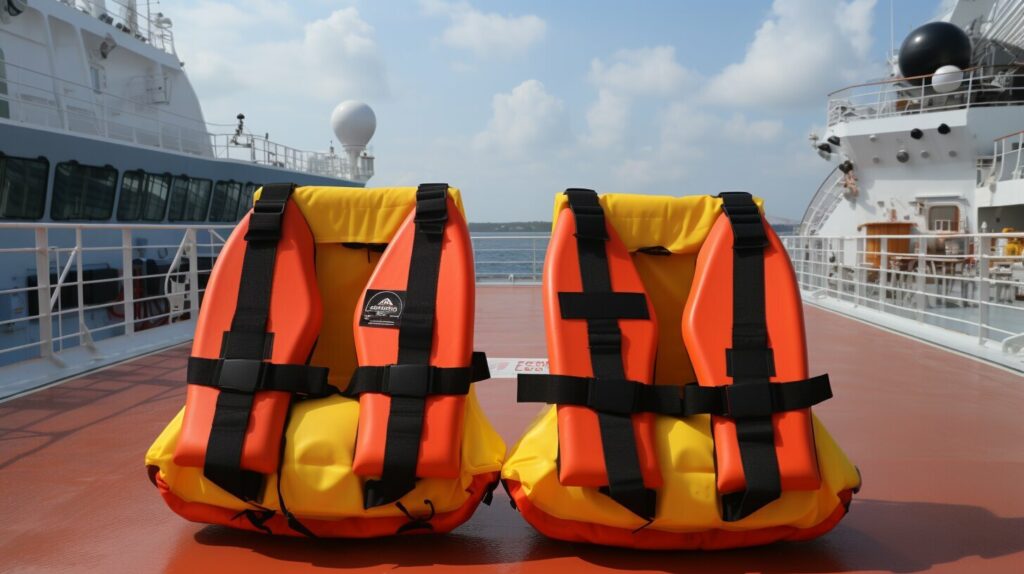
The respective evacuation procedures on aircraft carriers and cruise ships are a fundamental distinction between the safety precautions on each. While emergency evacuation routes and protocols for the crew are set down by aircraft carriers, cruise ships must take into account the vast number of passengers that are present. As a result, cruise ships frequently contain a number of muster stations where visitors must attend a safety training and get familiar with the ship's evacuation procedure.
Spreading of Outbreak and Disease
Aircraft carriers have a much lower incidence of norovirus outbreaks than cruise ships. This is because aircraft carriers have a more tightly controlled environment, with fewer people coming and going from the ship. Aircraft carriers have a number of measures in place to prevent the spread of norovirus, including:
- Strict hygiene procedures for food preparation and handling
- Frequent cleaning and disinfection of surfaces
- Screening of passengers and crew members for symptoms of illness
- Quarantining of people who are sick
These measures have been very effective in preventing norovirus outbreaks on aircraft carriers. In fact, there have been only a handful of norovirus outbreaks on aircraft carriers in the past few decades.
Did You Know : Norovirus is a highly contagious virus that causes vomiting and diarrhea. It is the leading cause of gastroenteritis outbreaks on cruise ships. The virus can be spread through contact with contaminated food, water, or surfaces. It can also be spread through person-to-person contact
Cruise ships, on the other hand, have a more difficult time preventing the spread of norovirus. This is because they have a much more open environment, with passengers and crew members coming and going from the ship all the time. It is also more difficult to enforce strict hygiene procedures on cruise ships, as there are simply too many people to monitor.
As a result, cruise ships are more susceptible to norovirus outbreaks than aircraft carriers. In fact, there have been a number of major norovirus outbreaks on cruise ships in recent years, including one in 2019 that affected over 500 people on the Royal Caribbean International .
Wrapping Up Cruise Ships vs Aircraft Carriers
In conclusion, even though cruise ships and aircraft carriers are both ocean monsters, their functions are completely different. Military aircraft carriers are created and constructed primarily to support naval operations with air power. Cruise ships, on the other hand, were created and built for profit, particularly to offer travelers opulent lodging and entertainment.
They differ in many ways than merely size and intended function. There are significant variations between the two in terms of structure and design, sleeping capacity and passenger experience, power source and propulsion systems, performance and speed, as well as safety and security measures.
Despite their distinctions, cruise ships and aircraft carriers both have large economic effects and are in charge of producing a sizable amount of tourism money. They both serve as examples of contemporary engineering wonders, even if their motivations for doing so are extremely different.
Q: What is the difference between an aircraft carrier and a cruise ship?
A: A cruise ship is a passenger ship used for entertainment and leisure travel, whereas an aircraft carrier is a sizable military vessel built to carry and launch military aircraft.
Q: How do aircraft carriers and cruise ships differ in size and purpose?
A: Aircraft carriers are developed for military purposes, primarily for launching and retrieving aircraft, and are substantially larger than cruise ships. Cruise ships are made to accommodate and amuse those traveling for fun.
Q: What are some notable examples of aircraft carriers and cruise ships?
A: The USS Gerald R. Ford and the USS Nimitz are two notable aircraft carriers. The Oasis-class ships from Royal Caribbean and the Carnival Vista are both well-liked cruise ships.
Q: What power sources and propulsion systems are used by aircraft carriers and cruise ships?
A: Nuclear reactors are commonly used to power aircraft carriers, while diesel engines or hybrid electric-diesel propulsion systems are more common aboard cruise ships.
Q: How do aircraft carriers and cruise ships differ in terms of accommodation capacity?
A: Aircraft carriers have a restricted capacity for crew personnel and are mostly utilized for military activities. On the other hand, cruise ships have a variety of cabin types and facilities and are built to carry a big number of guests.
Q: What roles do aircraft carriers play in the military and cruise ships in the commercial sector?
A: Aircraft carriers are essential to military operations because they act as mobile air bases and help militaries project their might internationally. On the other hand, cruise ships are primarily used for leisure travel and offer passengers entertainment and recreational activities.
Q: How do aircraft carriers and cruise ships impact the economy and tourism?
A: Aircraft carriers have a big economic impact since they help the defense sector and create jobs. Through tourism, cruise ships support local economies by generating income from port fees and passenger spending.
Q: What safety and security measures are implemented on aircraft carriers and cruise ships?
A: A variety of security precautions are in place on both aircraft carriers and cruise ships, which prioritize safety. However, due to their military nature, aircraft carriers have stricter security procedures.
About The Author
theblitzcorp.com
Related posts.
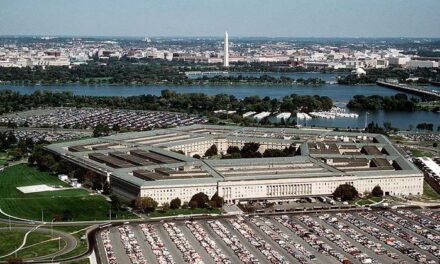
How Did Sensitive US Military Emails Spill Online
12 July 2023
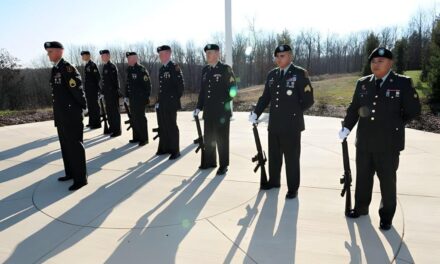
Military Police Uniform: A Guide to MP Gear and Apparel
11 August 2023
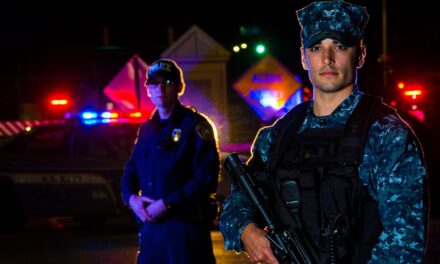
Guide to the Navy Military Police: A Master-At-Arms at Land or Sea
13 November 2023

Hamas vs Israel War Update: Death Toll Rises
11 December 2023
Leave a reply Cancel reply
Your email address will not be published. Required fields are marked *
Save my name, email, and website in this browser for the next time I comment.
Email address:
Recent Posts

Recent Reviews
- Battle Map Of Okinawa: Insights Into The Second World War Conflict Score: 0%
- The Evolution of Aerial Combat Score: 0%
- Naval Warfare | Wooden Ships to Modern Carriers Score: 0%
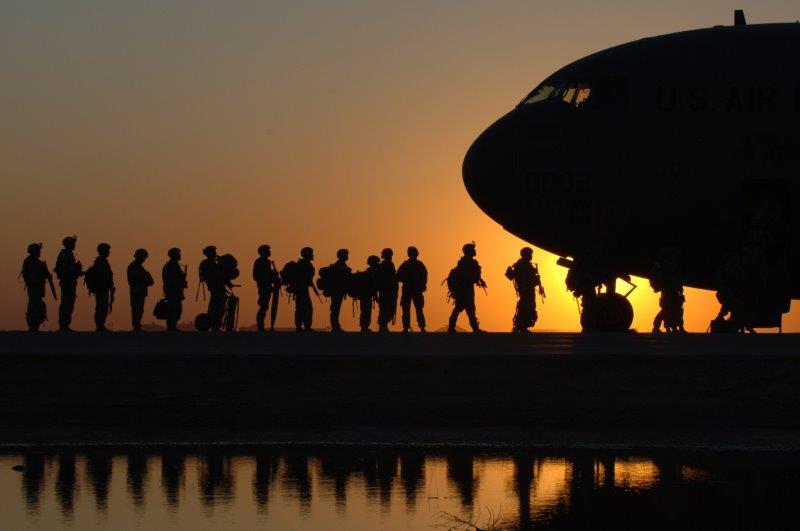

- Battle of Giants: Unveiling the Ultimate Showdown - Aircraft Carrier vs. Cruise Ship!
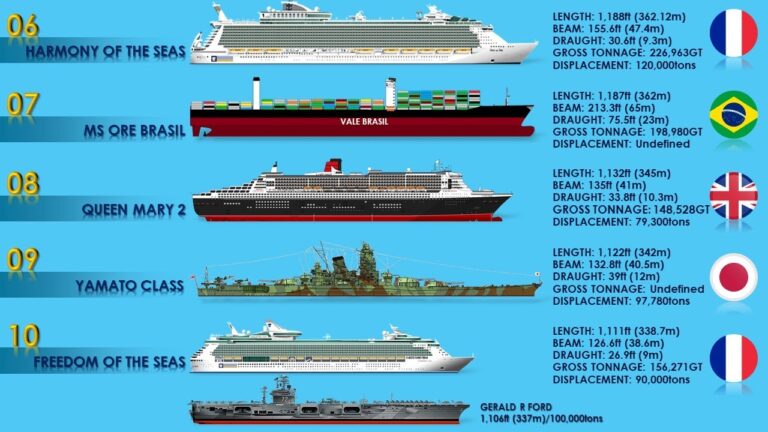
When it comes to colossal vessels dominating the seas, two types stand out: aircraft carriers and cruise ships. While both are massive in size and exemplify the marvels of modern engineering, they serve vastly different purposes. Aircraft carriers are the epitome of naval power, serving as floating airbases for fighter jets and other military aircraft. These behemoths are designed to project force and protect national interests across the globe. On the other hand, cruise ships are luxurious floating resorts, offering an array of amenities and entertainment options for vacationers seeking relaxation and adventure. With their towering decks, endless entertainment possibilities, and extravagant accommodations, cruise ships have become synonymous with leisure and escape. Although seemingly similar in size, these two types of vessels represent distinct worlds and cater to entirely different audiences. In this article, we will delve into the key differences between aircraft carriers and cruise ships, exploring their design, capabilities, and the experiences they offer to those on board.
- Purpose and Function: One key difference between an aircraft carrier and a cruise ship lies in their purpose and function. An aircraft carrier is a large military vessel designed to carry and launch military aircraft, serving as a mobile airbase for combat operations. On the other hand, a cruise ship is primarily designed for leisure and transportation purposes, providing amenities and entertainment options for passengers during their vacation or travel.
- Size and Capacity: Another notable difference is the size and capacity of these vessels. Aircraft carriers are considerably larger and more massive than cruise ships. They can measure over 1,000 feet in length, displace tens of thousands of tons, and accommodate a crew of several thousand sailors and officers. In contrast, while cruise ships can also be quite large, they are generally smaller in comparison and can carry thousands of passengers along with a considerably smaller crew.
- Defensive Capabilities: One significant contrast between aircraft carriers and cruise ships is their defensive capabilities. Aircraft carriers are equipped with advanced weapons systems, including surface-to-air missiles, anti-aircraft guns, and electronic countermeasures, to protect themselves from potential threats. Additionally, they have a sophisticated command and control infrastructure to coordinate military operations. In contrast, cruise ships typically focus on passenger safety and may have limited security measures, such as onboard security personnel and surveillance systems, to deal with emergency situations or prevent piracy incidents.
- Military Capabilities: One major advantage of an aircraft carrier compared to a cruise ship is its military capabilities. Aircraft carriers serve as mobile airbases that can carry and launch a variety of military aircraft, including fighter jets, helicopters, and surveillance planes. This allows for robust aerial defense and offense capabilities, making aircraft carriers crucial assets in military operations and national security. In contrast, cruise ships do not possess such capabilities and are primarily designed for leisure and transportation purposes.
- Global Power Projection: Another advantage of aircraft carriers over cruise ships is their ability to project global power. Due to their mobility and extensive range, aircraft carriers can be deployed to different regions of the world, providing a visible and tangible presence of a nation's military power. This power projection capability is particularly important in times of crisis or conflict, as aircraft carriers can quickly move to strategic positions, provide support to allied forces, and deter potential adversaries. Cruise ships, on the other hand, are limited in their range and primarily cater to tourism and transportation needs, lacking the ability to project military power on a global scale.
- Disadvantages
- Limited entertainment options: While cruise ships are known for their lavish amenities, including casinos, theaters, and multiple dining options, aircraft carriers typically offer limited entertainment facilities for their crew and passengers. Due to their primary focus on military operations, aircraft carriers prioritize functionality over luxury, which can be a disadvantage for those seeking a variety of entertainment choices.
- Higher risks and safety concerns: Aircraft carriers operate in high-risk environments, including combat zones and rough seas, which can pose significant safety concerns. Unlike cruise ships that prioritize passenger safety and comfort, aircraft carriers are designed primarily for military purposes, and individuals on board may be exposed to greater risks associated with potential accidents or combat situations.
- Limited privacy and personal space: Cruise ships often provide a range of cabin options, including spacious suites and private balconies, allowing passengers to enjoy their own personal space. However, on an aircraft carrier, both crew members and passengers have limited privacy due to the restricted living quarters and shared communal spaces. This lack of personal space can be a disadvantage for individuals who value privacy and solitude.
- Restricted itineraries and destinations: Cruise ships offer travelers the opportunity to explore various destinations, with the flexibility to dock at different ports and embark on shore excursions. In contrast, aircraft carriers are primarily used for military operations and are bound by strict itineraries and destinations dictated by strategic considerations. This limited flexibility can be a disadvantage for those seeking diverse travel experiences and the ability to explore multiple locations during their journey.
Which is larger, a cruise ship or an aircraft carrier?
How do cruisers and aircraft carriers differ from each other, is the uss gerald r ford larger in size compared to the titanic, taking to the seas: a comparative analysis of aircraft carriers and cruise ships, battleships of the sky and the sea: a closer look at aircraft carriers and cruise ships, navigating the waters: exploring the differences between aircraft carriers and cruise ships, floating giants: unveiling the distinctions between aircraft carriers and cruise ships.
In the realm of naval vessels, the size is a crucial aspect. When comparing cruise ships and aircraft carriers, it is evident that they are roughly the same length. The U.S. Navy's Gerald R. Ford holds the title of the largest aircraft carrier at sea, measuring 1,106 feet in length. In comparison, an average-sized cruise ship spans approximately 1,000 feet, which is akin to the length of three football fields. Both vessels showcase impressive dimensions, highlighting the grandeur of their respective purposes at sea.
Comparing the sizes of cruise ships and aircraft carriers reveals their remarkable dimensions, with the largest aircraft carrier, the Gerald R. Ford, measuring 1,106 feet in length, while an average-sized cruise ship spans about 1,000 feet, equivalent to three football fields. These impressive measurements emphasize the grandeur and importance of these vessels in the naval realm.
Cruisers and aircraft carriers differ in terms of offensive power. While aircraft carriers rely solely on their aircraft and helicopters for attacking enemies, aviation cruisers have an additional advantage. These cruisers are equipped with cruiser weaponry that allows them to engage a wide range of adversaries, including surface vessels, submarines, and aircraft. This added firepower gives aviation cruisers a more versatile and comprehensive approach to combat compared to aircraft carriers.
Aviation cruisers have a distinct advantage over aircraft carriers in terms of offensive power. Unlike aircraft carriers, which rely solely on their aircraft and helicopters for attacks, aviation cruisers are equipped with cruiser weaponry that enables them to engage a diverse range of adversaries, including surface vessels, submarines, and aircraft. This versatility gives aviation cruisers a more comprehensive approach to combat.
The USS Gerald R. Ford, the largest warship ever constructed, greatly surpasses the Titanic in terms of size. With a displacement of approximately 100,000 tons, the Ford dwarfs the Titanic's 50,000-ton displacement. This nuclear-powered carrier, serving as the flagship of the U.S. Navy, showcases the remarkable advancements made in naval technology since the ill-fated voyage of the Titanic. The Ford's colossal size further solidifies its status as a modern marvel in naval engineering and serves as a testament to the progress made in shipbuilding over the years.
The USS Gerald R. Ford, the largest warship ever built, surpasses the Titanic in size. With a displacement of about 100,000 tons, it far exceeds the Titanic's 50,000-ton displacement. As the flagship of the U.S. Navy, this nuclear-powered carrier exemplifies the incredible advancements in naval technology since the Titanic's tragic journey, solidifying its status as a modern marvel in shipbuilding.
Aircraft carriers and cruise ships are both colossal vessels that dominate the seas, but the similarities end there. While aircraft carriers are designed for warfare, cruise ships are built for luxury travel. Aircraft carriers boast advanced weaponry systems, a fleet of fighter jets, and a highly trained crew ready for combat. On the other hand, cruise ships prioritize entertainment, with multiple restaurants, swimming pools, and entertainment venues. Although both ships navigate the oceans, their purposes and features couldn't be more different.
Aircraft carriers and cruise ships may seem similar due to their large size, but their purposes and features set them apart. Aircraft carriers are designed for warfare, equipped with advanced weaponry and fighter jets, while cruise ships focus on luxury travel, offering entertainment venues and amenities for passengers to enjoy.
Aircraft carriers and cruise ships are both mammoth vessels that dominate the skies and seas, each with its unique purpose and capabilities. Aircraft carriers, known as the "battleships of the sky," serve as floating airbases, carrying a fleet of fighter planes and helicopters. These massive ships possess advanced technology and play a crucial role in projecting military power across the globe. On the other hand, cruise ships are luxurious floating resorts that offer unparalleled travel experiences. With their extravagant amenities and entertainment options, they cater to leisurely travelers, providing a unique way to explore the world's oceans. Although serving different purposes, both these colossal ships have captured the imagination of people worldwide.
While aircraft carriers are known for their military capabilities and ability to project power, cruise ships are renowned for their luxurious amenities and entertainment options, providing a unique travel experience for leisurely travelers. Both these mammoth vessels have captivated the imagination of people worldwide, albeit for different reasons.
Aircraft carriers and cruise ships may both sail the seas, but their purposes and designs couldn't be more different. While aircraft carriers are floating military bases, cruise ships are luxurious floating resorts. Aircraft carriers serve as mobile airfields, capable of launching and recovering fighter jets, helicopters, and other aircraft. In contrast, cruise ships are designed for leisure, offering amenities such as swimming pools, restaurants, and entertainment options. Understanding the distinctions between these two types of vessels helps us appreciate their unique roles and contributions in today's maritime world.
Aircraft carriers and cruise ships may both navigate the oceans, but their purposes and designs vary greatly. While aircraft carriers function as military bases with the ability to launch and retrieve aircraft, cruise ships are luxurious resorts that prioritize leisure and entertainment for their passengers. Recognizing the differences between these vessels allows us to acknowledge their distinct roles and significance in the maritime industry.
Aircraft carriers and cruise ships may appear similar at first glance, both being colossal vessels that traverse the oceans. However, a closer look reveals distinct differences between the two giants of the sea. While cruise ships are designed for luxury and entertainment, offering a plethora of amenities and activities, aircraft carriers are military powerhouses, serving as mobile airbases for launching and recovering fighter aircraft. The primary purpose and functionality of these floating giants set them apart, with one catering to leisure and the other projecting military might.
While aircraft carriers and cruise ships may share similarities in their size and appearance, their purposes and functions are fundamentally different. Cruise ships prioritize luxury and entertainment, while aircraft carriers serve as military platforms for fighter aircraft. These distinct roles make them unique and separate entities on the high seas.
In conclusion, while both the aircraft carrier and the cruise ship are massive vessels that dominate the seas, they serve vastly different purposes. The aircraft carrier is a symbol of military might and power projection, capable of launching and recovering various aircraft in support of combat operations. It is a floating base that enables a nation to project its influence globally. On the other hand, the cruise ship is designed to provide luxurious accommodations and entertainment for passengers seeking a leisurely vacation experience. It offers a wide range of amenities, including fine dining, entertainment shows, and recreational activities. Despite their contrasting roles, both the aircraft carrier and the cruise ship showcase human ingenuity and engineering marvels. Whether it be the advanced technology and weaponry of an aircraft carrier or the opulent interiors and state-of-the-art facilities of a cruise ship, these vessels epitomize our ability to conquer the vastness of the seas and cater to our ever-evolving needs and desires.
- Unveiling the Mysterious Reasons to Avoid the 3AM Mirror Gaze
- Instantly Ruin Car Paint: Unveiling the Ultimate Guide!
Unlocking Data Insights: Exploring the Benefits of Pursuing a Master's in Applied Statistics in India
The Hidden Gems of New Brunswick: Remarkable Diamond Discoveries
Unlocking Insights: Exploring Statistical Analysis and Data Reconfiguration
Mastering Math: A Journey of Learning as an Adult
How Many Liters in 8 oz: Conversion and Fun Facts
Unveiling the Delicious Mystery: How Much Does an Oreo McFlurry Cost?
LMIA Eligibility for International Students: Can You Obtain an LMIA While on a Study Permit?
Understanding the Duration: How Long Does a Safety Certificate Last?
How Much Concrete Fits Inside a Truck: A Complete Guide
Exploring the Longevity of an Engine Post Head Gasket Replacement
Exploring the Duration of a Master's Degree in Canada: Unveiling the Time Commitment
Wasp Invasion: Uncovering the Mystery of Lots of Wasps Without a Nest

Cruise Ships vs Aircraft Carriers – Which One Is The Best?
Cruise ships are famous worldwide for entertainment. They carry thousands of passengers, providing them services of a luxury hotel on the sea. Aircraft carriers are costly, and only certain countries have them. So, cruise ships vs aircraft carriers, who has more power in the sea?
Let us find out.
Cruise ships vs aircraft carriers: which one rules the sea?
Cruise ships.
Traveling on a cruise ship is a fantastic experience anyone can have on the sea. Cruise ships can include more than a thousand passengers and travel them to their desired location in a luxurious trip. Do you know that the “Wonder of the Seas” cruise ship can hold 6,988 guests in addition to 2,300 staff members?
Cruises are currently a very popular form of tourism all over the world, and businesses involved in the industry are continuously working to attract new customers by providing luxurious, cutting-edge products. It is amazing to view the size of the ship. And it is much more amazing to go on it and enjoy its inside, which is like a miniature floating metropolis.
What is the best carnival cruise ship?
Aircraft carriers
An aircraft carrier is a ship with a flight deck that serves as an airport for taking off and landing aircraft. The aircraft carrier is a sign of power among the most powerful military in the world. It enables the global deployment of military aircraft without relying on fixed sites because it has a full-length flight deck.

Here are a few facts about why Aircraft carriers are so powerful.
- The US Navy used two freshwater aircraft carriers to train its pilots during World War II on the Great Lakes.
- A single US aircraft carrier possesses an air force more potent than 70% of all nations combined.
- The aircraft carrier of the Nimitz class can function for twenty years without refueling.
- The Gerald R. Ford Class, the newest class of US aircraft carriers, has a daily operating cost of $7 million.
- Only France, outside the United States, has ever constructed an aircraft carrier fueled by nuclear energy.
- Producing an aircraft carrier will cost $4.5 billion.
- Aircraft carriers can accommodate 90 aircraft.
To read more about aircraft carriers, visit here .
To see>>The World’s Biggest Aircraft Carrier
As you can see, both ships have a higher value in each field they operate. Let’s compare to see who has more power on the sea.
Let us take two ships from each side to see who thrives in this category. Harmony of the Seas from cruise ships and USS Gerald Ford from aircraft carriers.
- Length (OA) – 1187 ft.
- Width (Waterline) – 155.6 ft.
- Draft – 30.6 ft.
- Displacement: 120,000 Metric Tons
- Length (OA) -1106 ft.
- Width (Waterline) – 134 ft. (Flight Deck)- 256 ft.
- Draft – 39 ft.
- Displacement: 100,000 Metric tons
By being 81 feet long, the Harmony of the Seas easily surpasses the USS Gerald Ford in length. Although it is 21.6 feet wider at the water’s edge, Ford’s hull has a large flare to make room for the flight deck and aircraft lifts, which significantly outweighs that measurement.
Over 30% more water is drawn by the USS Gerald Ford than by the Harmony of the Seas. The USS Gerald Ford, the aircraft carrier, is the victor in the size category due to this indication of its bigger bulk.
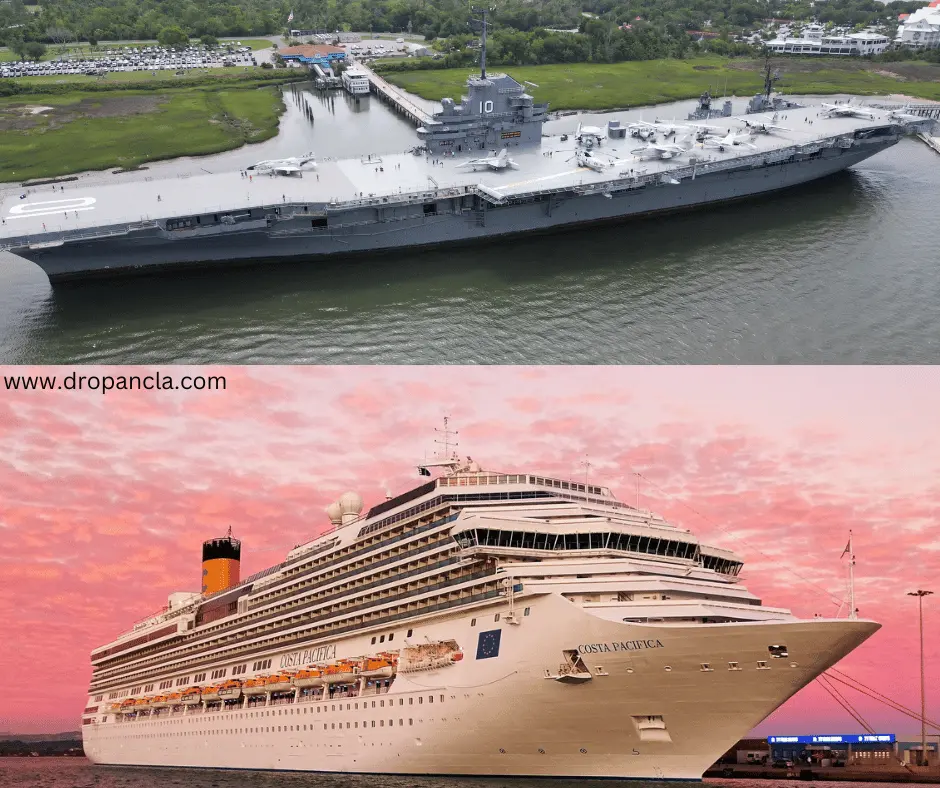
Cruise ships vs aircraft carriers – Dimensions
For this comparison also, we will use data from a few of the newest and largest ships in both classes. The Royal Caribbean cruise liner Oasis of the Sea and the US aircraft carrier USS Gerald Ford. Weight and length are factors considered in this comparison.
Both measure approximately 1200 feet in length. (Ford 1106, Oasis 1186) However, the Oasis of the Sea weighs 225,000 tons as opposed to Gerald Ford’s about 100,000 tons. The USS Gerald Ford is smaller than the Oasis of the Sea. Cruise ships would triumph in terms of dimensions.
Advantages of cruise ships vs aircraft carriers
- You do not have to travel from one place to another or unpack at every hotel, which makes it incredibly comfortable.
- On board the ship, all services are accessible.
- Cruises offer kid-friendly activities and events that are included in the price for people traveling with kids.
- Compared to a typical trip, you can visit more locations while seeing well-known tourist attractions.
- Encourage social interactions
- Diverse activities to suit every preference.
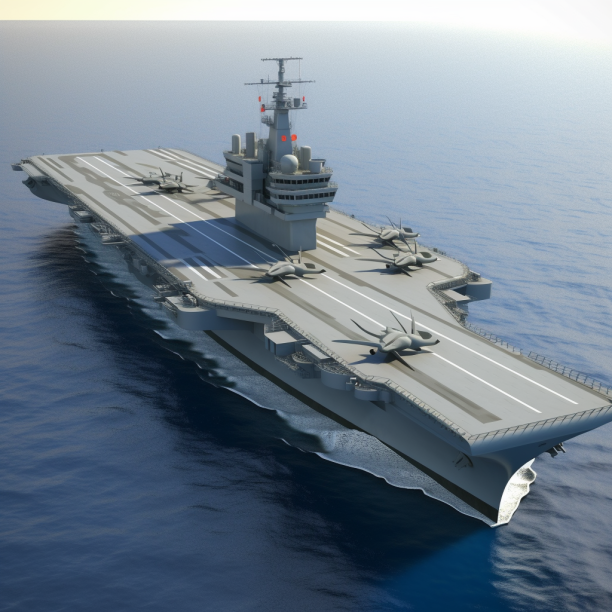
- A portable base that can be positioned wherever there is an ocean.
- Can fight at any time and have a lot of portable fire powers.
In regards to cruise ships vs aircraft carriers, they both have their triumphs in different areas. They both offer their respective nations numerous benefits. Both cruise ships and aircraft carriers are distinctive in their respective industries. And they both rule the sea when they are developed in their way.
Similar Posts

Cruise ship comedians bring laughter to the high seas
Cruise ships are a great way to travel and see the world. And they are also a place to enjoy some entertainment and laughter. Comedy is one of the most popular ways of entertainment on cruise ships. Comedians on cruise ships have to make people laugh in a confined space. And they have to do…
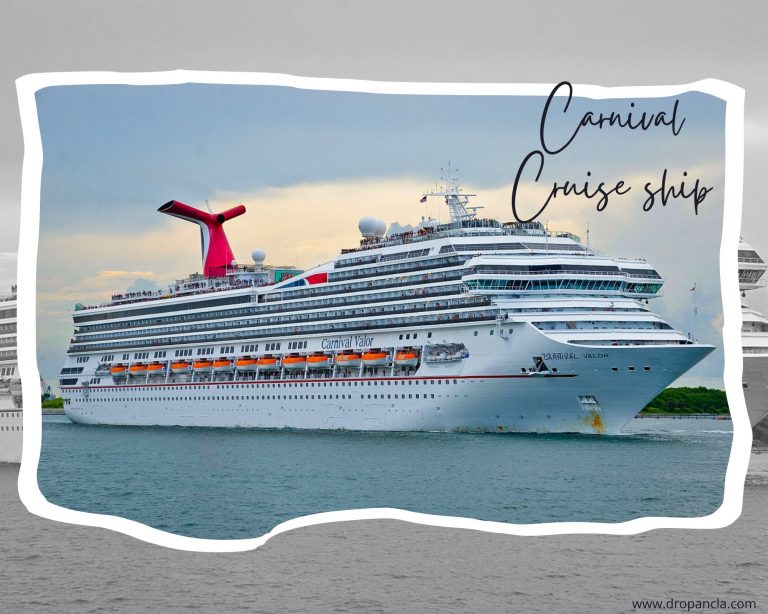
Have some fun! Go on a cruise! -best Carnival Cruise ship
Hey Readers, this time, it’s all about cruising over the blue waters to distant faraway lands…!Have you ever wondered about being on a Carnival Cruise ship? What Exactly is a cruise ship? And what is the best Carnival Cruise ship? Let’s find out. What is a cruise ship? Cruise ships are larger passenger ships specially designed…

Does a cruise bring you back? A comprehensive guide to cruising
Have you ever thought about what it’s like to go on a cruise? You may have seen photos of people partying on a massive ship or heard stories of amazing adventures in exotic places. Or are you just wondering how cruises work and how much they cost? If that’s the case, this article is perfect…
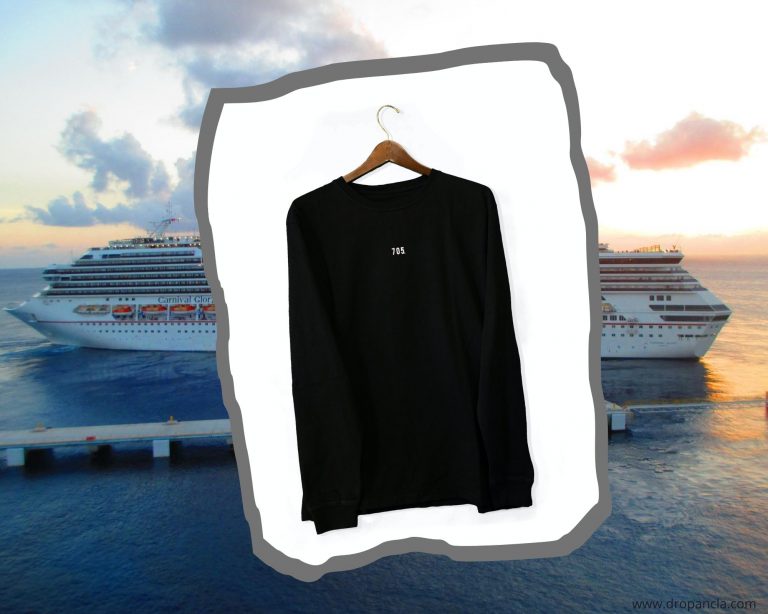
The cheapest way to ship a shirt -Is Shipping Expensive?
Hey dear readers? Here we are again with an informative write-up on one of the common topics- Shipping. Though the topic seems familiar, it is less discussed. So let us dig into more information on this so that everyone can use the knowledge when they need to. Here are some valuable tips on the cheapest way…
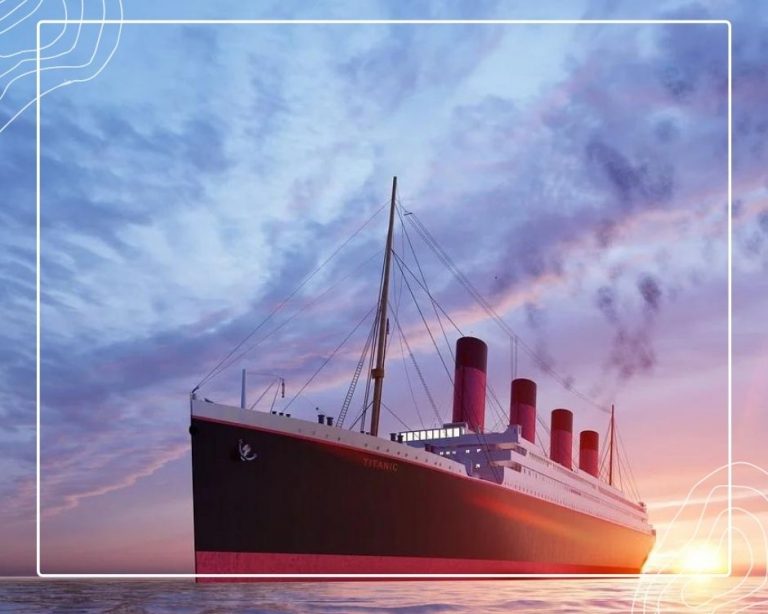
Remembering the Beauty of the sea! Titanic compared to a cruise ship
Titanic compared to a cruise ship –Hello readers! Here we are once again, with a super exciting topic. The legend of the Sea “Titanic”! As soon as you hear the name, we are sure most of you are curious to know more details about Titanic. The mystery lies in the sea bed from the day…

An Overview Of The MARSEC Security & Its Domain In The Maritime Industry
Are you interested in MARSEC? If you want to protect maritime assets and operations from threats and risks, consider exploring this field further. In this article, we discover what Marsec security is, why it matters, and what are some of the best practices and innovations in this sector. Are you curious about Marsec security? What…
Leave a Reply Cancel reply
Your email address will not be published. Required fields are marked *
Save my name, email, and website in this browser for the next time I comment.

Cruise Ship VS Aircraft Carrier
- January 10, 2024
Cruise ships and aircraft carriers are both ocean giants, though they serve different purposes and have very different sizes. An aircraft carrier’s main job is to act as a mobile base for military aircraft such as fighter jets and helicopters. In contrast, a cruise ship is built for pleasure and offers travelers a floating hotel experience.
Massive boats and aircraft carriers are typically 800-1000 feet long and over 100,000 tons in weight. Extreme weather, tremendous speeds, and the impact of aircraft takeoffs and landings are all things they are designed to withstand. The passenger capacity of cruise ships, on the other hand, is typically higher than that of aircraft carriers, with a normal length of 1000–1200 feet and a weight of 100,000–220,000 tons.
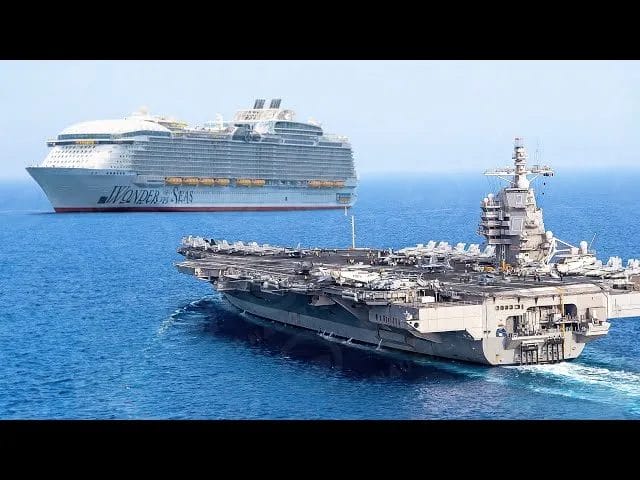
Content Sections
CONSTRUCTION AND DESIGN FEATURES
The structure and features of cruise ships and aircraft carriers are very different. Although both ships are built to survive the hardships of ocean travel, their respective missions and operating needs necessitate special design elements.
Fighter jets, helicopters, and other types of aircraft can be launched from and recovered by aircraft carriers, which are vessels designed expressly for naval combat. As a result, they have enormous flight decks for operating aircraft and are made to fit big air squadrons.
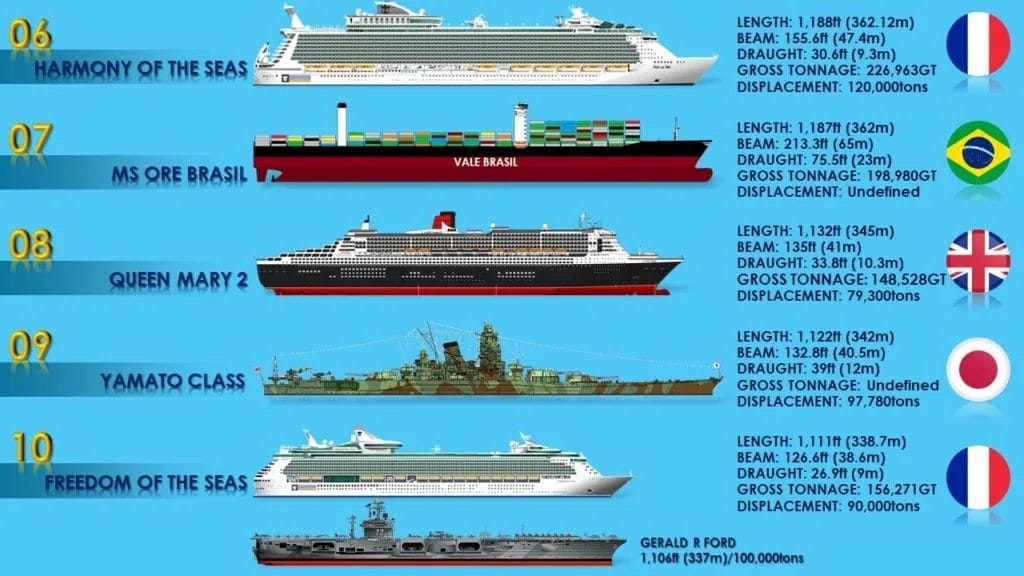

Size and Dimensions
- The Oasis of the Seas cruise ship is larger than the USS Gerald Ford aircraft carrier in terms of weight (225,000 tons vs 100,000 tons) and length (1186 ft vs 1106 ft). However, modern aircraft carriers can be quite large, with some exceeding 1000 ft in length.
- A cruise ship’s top speed is 22–24 knots (41–44 km/h), but an aircraft carrier can typically go at 30-35 knots (55–65 km/h). Due to their different purposes, cruise ships prioritize luxury over speed, whereas aircraft carriers must be able to move swiftly to defend against potential attacks.
Intended Purpose and Features
- Cruise ships are designed for leisure travel and entertainment. They emphasize amenities for passengers and can carry over 6000 people.
- Aircraft carriers are military vessels designed to launch and recover aircraft. They feature weapons, aircraft launch/recovery equipment, and more basic crew quarters.
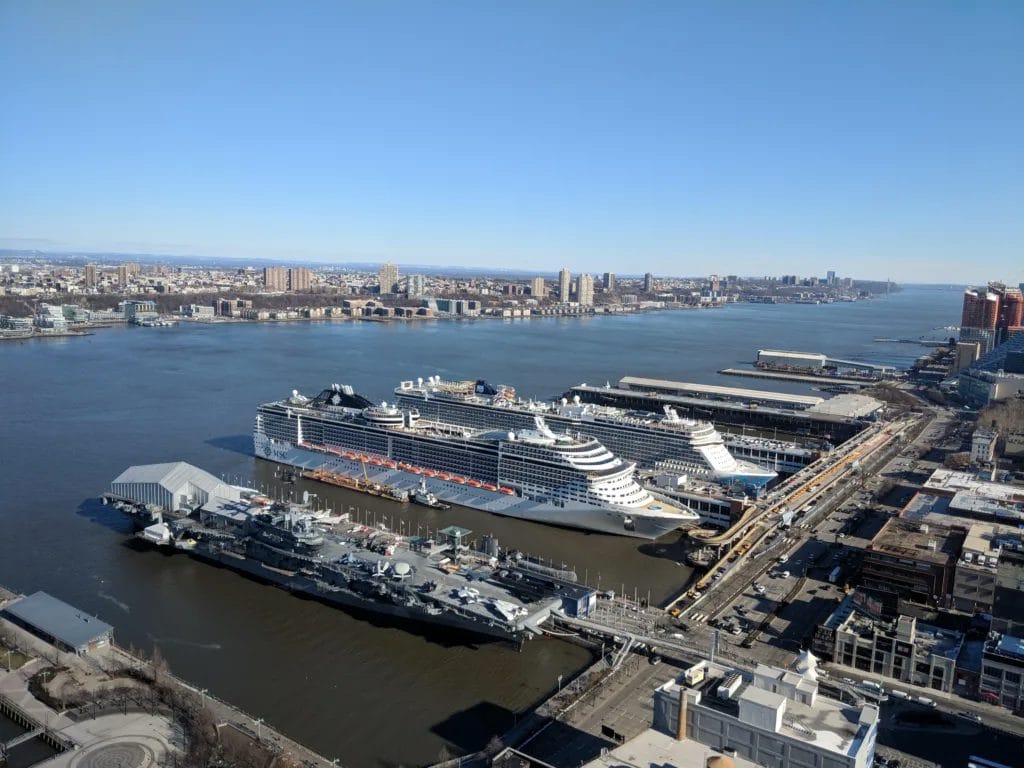
Propulsion and Speed
- Cruise ships use diesel engines for propulsion and have a top speed of around 25 knots.
- Aircraft carriers are powered by nuclear reactors giving almost unlimited range and can reach speeds over 30 knots.
Safety and Security
- Cruise ships have safety measures for storms but generally operate under peaceful conditions.
- Aircraft carriers are built to withstand battle damage and feature extensive water-tight compartments, fire suppression, and weaponry.
The security and safety of the crew and guests are also top priorities on cruise ships. Numerous safety precautions, including lifeboats, fire suppression systems, and cutting-edge navigational equipment, are included on these vessels. Closed-circuit television (CCTV) systems and security staff are also provided on modern cruise ships to keep an eye out for any potential security risks.
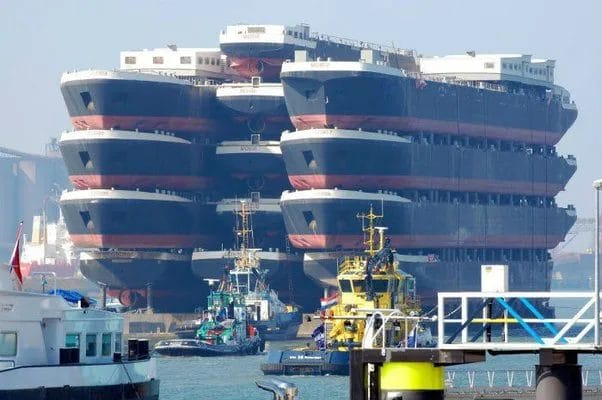
Economic Impact
- The cruise industry generates over $150 billion annually and employs over 1 million people.
- Aircraft carriers project naval power and provide deployable air bases around the world to protect national interests.
Additionally, both cruise ships and aircraft carriers are crucial to the tourism sector. These enormous ships are frequently visited and explored by tourists, which enhances the whole tourism experience. In reality, a few cruise lines provide excursions that feature visits to retired aircraft carriers.
However, the COVID-19 pandemic has affected the tourism sector, with numerous nations barring their ports from cruise liners. With cruise companies establishing tight health and safety procedures, the sector is gradually rebounding. However, it is impossible to overstate the economic contribution and significance of both cruise ships and aircraft carriers to the travel and tourism sector.
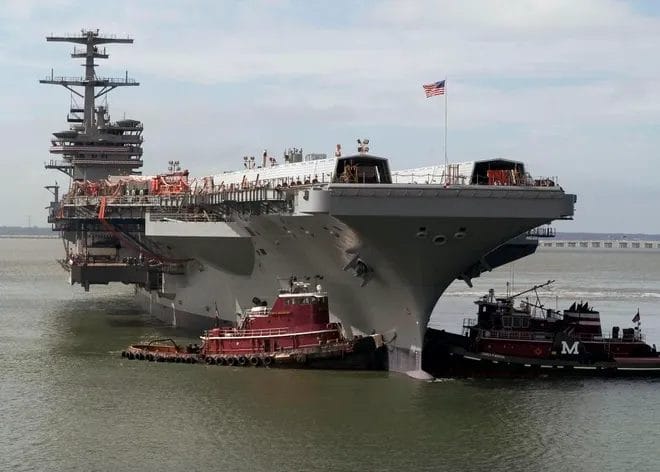
WRAPPING UP CRUISE SHIPS VS AIRCRAFT CARRIERS
In conclusion, even though cruise ships and aircraft carriers are both ocean monsters, their functions are completely different. Military aircraft carriers are created and constructed primarily to support naval operations with air power. Cruise ships, on the other hand, were created and built for profit, particularly to offer travelers opulent lodging and entertainment.
They differ in many ways than merely size and intended function. There are significant variations between the two in terms of structure and design, sleeping capacity and passenger experience, power source and propulsion systems, performance, and speed, as well as safety and security measures.
So in summary, while both are impressive feats of engineering, cruise ships focus on hospitality and comfort, while aircraft carriers fulfill specialized military roles – reflected in their vastly different designs and capabilities.
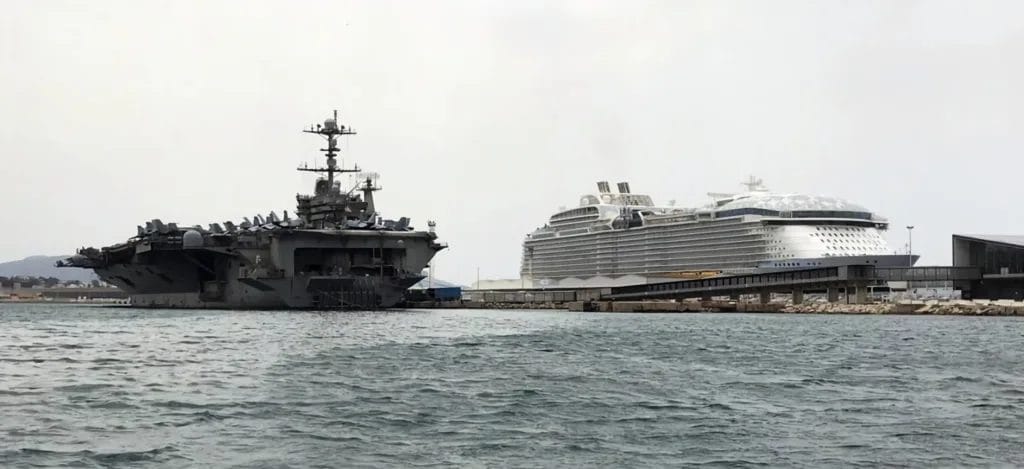
- Recent Posts
- Gujarat Police Logo - January 25, 2024
- CSC Logo - January 25, 2024
- Lata Shabd Roop - January 25, 2024
hmnamaqsood
Related posts.
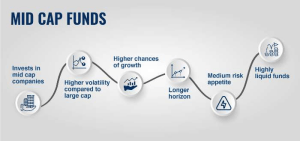
Reasons to Invest in DSP Midcap Fund Direct Growth
- April 1, 2024

How To Choose The Right Film Production House In Dubai
- March 21, 2024
Take Control Of Business Expenses With Expense Management
- March 18, 2024

Tips to use anonymous IG story viewer without affecting privacy security
- March 17, 2024
Leave a Reply Cancel Reply
Your email address will not be published. Required fields are marked *
Name *
Email *
Add Comment *
Post Comment
- Royal Caribbean International
Oasis/Allure vs. Nimitz aircraft carrier in weight
By JokerABC , October 28, 2011 in Royal Caribbean International
Recommended Posts

I was doing my research while waiting for my next cruise, so for the engineering and mechanical types, how does the Nimitz class aircraft carrier compare with Oasis and Allure with regard to the actual mass of the ship?
Many people confuse displacement with gross tonnage (GT). Obviously, Oasis has more GT at 225,000, and that is the measure of internal volume. But both ships have the same displacement, which is the weight it puts on the water.
"Her displacement —the actual mass of the vessel—is estimated at approximately 100,000 tons, about the same as that of an American Nimitz -class aircraft carrier ."
Length: 1181 ft(Oasis) and 1092 ft(aircraft carrier)
Beam, or width: 198 ft. extreme, 154 ft. waterline, (Oasis) and 252 ft. extreme, 134 ft. waterline (aircraft carrier)
Height: 236 ft(Oasis) and 240 ft(aircraft carrier, to top of control island tower)
The Nimitz class as 2 nuclear reactors as engines, so moves much faster at over 30 knots.
Anybody else have any thoughts or other information on the size comparison of the 2 biggest class of ships in the world for the engineering nerds and mechanical types?
Link to comment
Share on other sites.

I can neither confirm nor deny any questions asked about our US Navy Carriers.
The Oasis/Allure can only land one helicopter at a time. An aircraft carrier can handle well, more than one. :)

Rancher Dave
Crew : Pax ration is far better on the USNS than the Oasis class...
Dress code more likely followed on the carrier than on Oasis....:eek:

Think the USNS can hold more total fuel also.

Carrier says; "Choice Air? We don't need no stinkin' Choice Air!"
Major differences:
Nimitz - No one wears hats in the dining facilites (except the people cooking).
Nimitz - Upgrades in "status" are truly earned and status pins on clothing are mandatory.
Oasis - Beds are more comfortable.
Oasis - You can yell at the officers and not be Court Martialed.
In a race, Nimitz would blow Oasis' hatches off.
So far, the quote is my favorite comment.....
And here is the next.........ah........thought......... :eek:
Can the Nimitz parrallel park ? :p Who cares how fast you get there if you have to park 3 miles from the shop? :rolleyes:
.thumb.jpg.6d00ef34b87ecbca24bebb36efd924e0.jpg)
MDR On The Nimitz:
MDR on Oasis:
And guess who complains the most???

The Big Booper
Major differences: Nimitz - No one wears hats in the dining facilites (except the people cooking). Nimitz - Upgrades in "status" are truly earned and status pins on clothing are mandatory. Oasis - Beds are more comfortable. Oasis - You can yell at the officers and not be Court Martialed. In a race, Nimitz would blow Oasis' hatches off.
On a cruise we took several years ago, one of our tablemates was an experienced power plant engineer who was the lead, for one project, of designing and installing upgrades to the power system of one of the carriers. For a week he played Captain of the ship as his team ran the shakedown cruise of the ship to make sure that everything was working correctly, including running some actual launch and recovery cycles of the F 18s.
He was told, indirectly, that the carrier has a max speed of over 60 knots. That is some movin' and groovin'.

klingoncruiser
LOL... .what fun this thread is. Keep it up!
Oasis.... price per person
Nimitz.... free (well, they do make you work for your passage though):D

I think the most accurate measure is deadweight.
Oasis - depends on the number of pax compalining about tips; rum-runners; formal wear; or MDR food. Directly correlated to the number of chair hogs/sea day.
Nimitz - depends on how full the brig is
On a cruise we took several years ago, one of our tablemates was an experienced power plant engineer who was the lead, for one project, of designing and installing upgrades to the power system of one of the carriers. For a week he played Captain of the ship as his team ran the shakedown cruise of the ship to make sure that everything was working correctly, including running some actual launch and recovery cycles of the F 18s. He was told, indirectly, that the carrier has a max speed of over 60 knots. That is some movin' and groovin'.
One of my duties when I was in the Navy onboard an aircraft carrier had to do with ships speed. Trust me when I say any of the cruise ships built today do not stand a chance with speed and manuveurs of a carrier. Of course when we were steaming full speed you could really feel it. I think that may have been where they got the term batten down the hatches.
That's what he said.
He also said that he was told that after finishing a deployment in the MidEast the carrier raced back to it's home port (Va?) and beat the support ships by 36 hours. Guys running the carriers have the mindset of Jet Jockeys.

I can tell y'all... ;)
After spending 9 months in our "compartment" (the name for a berthing space cabin) aboard
our aircraft carrier, with NO WINDOWS/Portholes or "verandas", and, sleeping in what was called "racks"..
A week, in an "inside stateroom" aboard a cruise ship is heavenly...and, even enjoyable... :p
Something tells me the captain of the carrier doesn't host a champagne cocktail reception.
garnetpalmetto
That's what he said. He also said that he was told that after finishing a deployment in the MidEast the carrier raced back to it's home port (Va?) and beat the support ships by 36 hours. Guys running the carriers have the mindset of Jet Jockeys.
That's because generally they are - it's actually law that all CVN COs have to have been naval aviators or naval flight officers.

Comparing apples to oranges here.
Other than being designed to float, their engineering designs are totally different.

I can tell y'all... ;) After spending 9 months in our "compartment" (the name for a berthing space cabin) aboard our aircraft carrier, with NO WINDOWS/Portholes or "verandas", and, sleeping in what was called "racks".. A week, in an "inside stateroom" aboard a cruise ship is heavenly...and, even enjoyable... :p
you think that's bad, you should be doing a cruise as a member of a Marine rifle company. an inside is like the Ritz Carlton.

I'm guessing the "persons per bathroom ratio" is much, much better on the Oasis than the Nimitz. That said, I'd love to take a cruise on both of these vessels. (As a passenger, that is. I'm not too keen on the idea of working on a cruise.)

Universe93B
The Oasis was compared to the aircraft carrier often when it was under construction. The displacement is the best measure here to compare the mass of the two ships. That's how much pressure is put on the water by the ship. So the Nimitz aircraft carrier and Oasis weighs the same.
Actually we do. When we have been at sea over a 100 days with no liberty each sailor is entitled to two bottles of beer each. We called it steel beach and had steaks grilled to go with our beer. Fact.
Comparing apples to oranges here. Other than being designed to float, their engineering designs are totally different.
You are absolutely right. We're just having some fun.
War ship / Cruise ship .........
Fight/survive / Sleep in Comfort /eat too much-
.......................... / ......fight for seats/ survive casino
Here is another serious point :D .....
I love to feel the roll of the sea, I love the sea air ,and I love to travel; BUT I could never wear white :rolleyes: so I had to buy a ticket on RCI .............:p
Not really, displacement also factors in hull shape, length, width, carriage, and distribution of mass (center of gravity).
The only true measure is deadweight (the mathematical sum of the weight of all of the materials that were used in construction (factors out people/provisions/fuel/carriage - which are variables). The deadweight of Oasis/Allure is 25,000 tons.
Not really, displacement also factors in hull shape, length, width, carriage, and distribution of mass (center of gravity). The only true measure is deadweight (the mathematical sum of the weight of all of the materials that were used in construction (factors out people/provisions/fuel/carriage - which are variables). The deadweight of Oasis/Allure is 25,000 tons.
Then what is the deadweight of a Nimitz class vessel? Curious minds.......
This topic is now archived and is closed to further replies.
- Welcome to Cruise Critic
- New Cruisers
- Cruise Lines “A – O”
- Cruise Lines “P – Z”
- River Cruising
- Cruise Critic News & Features
- Digital Photography & Cruise Technology
- Special Interest Cruising
- Cruise Discussion Topics
- UK Cruising
- Australia & New Zealand Cruisers
- Canadian Cruisers
- North American Homeports
- Ports of Call
- Cruise Conversations
Announcements
- New to Cruise Critic? Join our Community!
Write Your Own Amazing Review !

Click this gorgeous photo by member SUPERstar777 to share your review!
Features & News

LauraS · Started Tuesday at 11:57 PM
LauraS · Started Tuesday at 06:52 PM
LauraS · Started Tuesday at 04:16 PM
LauraS · Started Monday at 08:25 PM
LauraS · Started Friday at 06:20 PM
- Existing user? Sign in OR Create an Account
- Find Your Roll Call
- Meet & Mingle
- Community Help Center
- All Activity
- Member Photo Albums
- Meet & Mingle Photos
- Favorite Cruise Memories
- Cruise Food Photos
- Cruise Ship Photos
- Ports of Call Photos
- Towel Animal Photos
- Amazing, Funny & Totally Awesome Cruise Photos
- Write a Review
- Live Cruise Reports
- Member Cruise Reviews
- Create New...
Cruise Spotlight
Helping you find cruise ships you'll love

Cruise Ship Comparison Tool
Can’t decide between two cruise ships? Our Cruise Ship Comparison Tool will let you see the differences between two ships. We did all the research to make it easy for you. Look at the differences in size, number of guests, types of food, and various activities. We also help you compare how much is included so you know how much you might end up spending on board.
Our Cruise Ship Comparison Tool lets you look at the following:
- Number of guests
- Number of crew
- Dining options and menus
- Includes versus extra fee dining options
- Bars and menus
- Features and ammenities
- Onboard costs like gratuities, drinks, and internet
Choose two ships below to see how they compare to each other.
First ship:
Second ship:
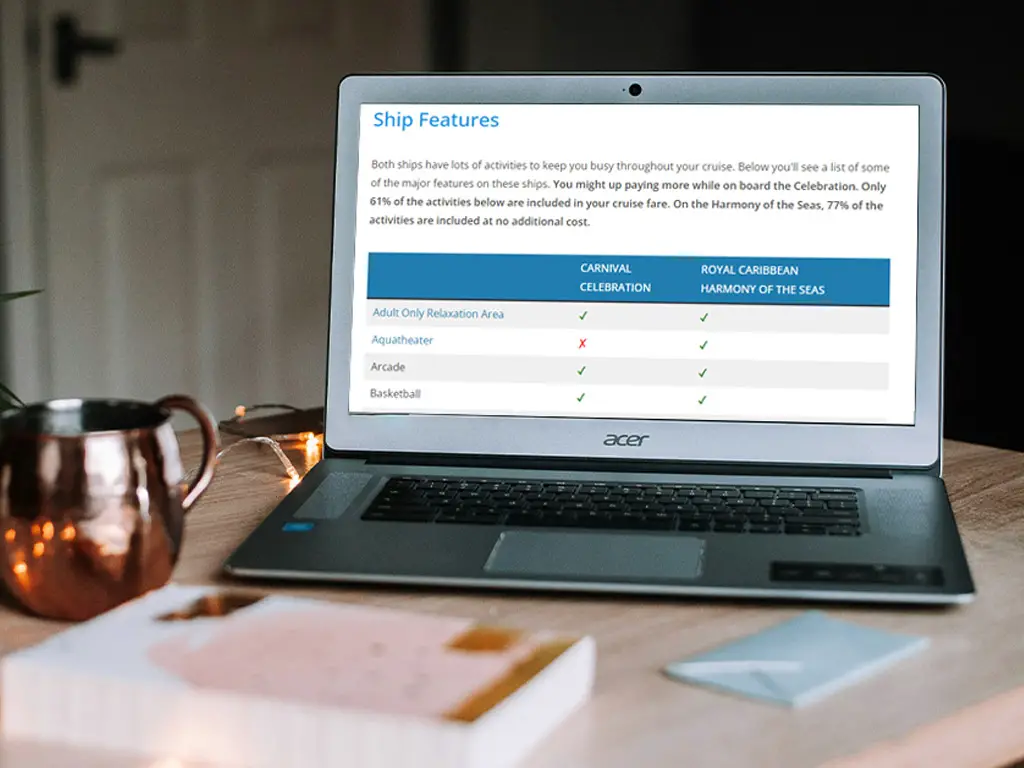

Cargo Ships vs Aircraft Carriers: Which Is Bigger?
If you’ve ever seen an aircraft carrier up close, you will know that they are imposingly massive. The flared shape of their hull as you look up toward the flight deck makes them seem intimidating and impressive, and you might get the sense that nothing much bigger would even float!
However, you might be surprised to know that the world’s biggest cargo ship is significantly bigger than the world’s biggest aircraft carrier .
At 400 metres long and 61.5 metres wide, Evergreen Marine’s Ever Alot is the biggest container ship ever built.
Currently serving trade routes between Europe and the Far East, Ever Alot is 63 metres longer than the largest ever aircraft carrier, the USS Gerald R. Ford .
There is one figure in the above table that stands out – even the biggest cargo ships can be run fairly efficiently on between 20-30 crew.
On cargo ships, merchant seafarers are trained to be multi-discipline experts, while the vast majority of the crew on cruise ships are housekeeping and galley staff. Governmental defence budgets allow warships to have as many crew as they need.
Is Ever Alot the biggest ship ever built?
At the time of writing, Ever Alot is the largest container ship ever built, although shipping companies frequently try to out-do each other by building ships marginally bigger than their competitors’ ships.
Shipping company MSC claims that its newest container ships are the biggest ever built. They are dimensionally identical to Ever Alot but can allegedly carry a few more containers than Ever Alot . However, because there is a lack of data on these vessels we are using Ever Alot , which can carry over 24,000 shipping containers, as our example.

It’s hard to imagine a ship bigger than Ever Alot . However, Ever Alot is not the biggest cargo ship ever built. There have been several oil tankers bigger than Ever Alot , and none bigger than the Seawise Giant.
When compared to the USS Gerald R. Ford , the Seawise Giant – also known during its lifetime as Oppama , Happy Giant , Jahre Viking , Knock Nevis , and Mont – is even more impressive.
Seawise Giant was capable of carrying 4.1 million barrels of oil and was in operation for 31 years before being scrapped in 2010.
Never mind the length and beam – just look at that difference in displacement!
The world’s biggest cruise ship
Royal Caribbean’s Allure of the Seas is the biggest cruise ship ever built. Although shorter in length than the Ever Alot , she is still longer, and wider – at the waterline – than the USS Gerald R. Ford .
Capable of carrying 2,200 crew and 6,780 passengers, Allure of the Seas is an impressive feat of naval architecture and engineering.
Of course, cruise ships and cargo ships are built for very different purposes than aircraft carriers.
So while you won’t find an ice skating rink, rock climbing walls, spas, or dozens of nightclubs and bars onboard USS Gerald R. Ford like you can on Allure of the Seas , she does have one incredible piece of kit that can’t be found on any of the biggest cargo or cruise ships – something than means that USS Gerald R. Ford won’t have to refuel for twenty years.
It’s not all about size – aircraft carriers are still incredible vessels
Although there may be longer and wider ships, the world’s biggest aircraft USS Gerald R. Ford holds a number of records in its own right.
She is not only the largest warship ever built; she is also the most expensive ship ever built.
The Congressional Research Service estimates the vessel’s build cost at $13.3 billion. This figure does not include several billion additional dollars spent on research and development.
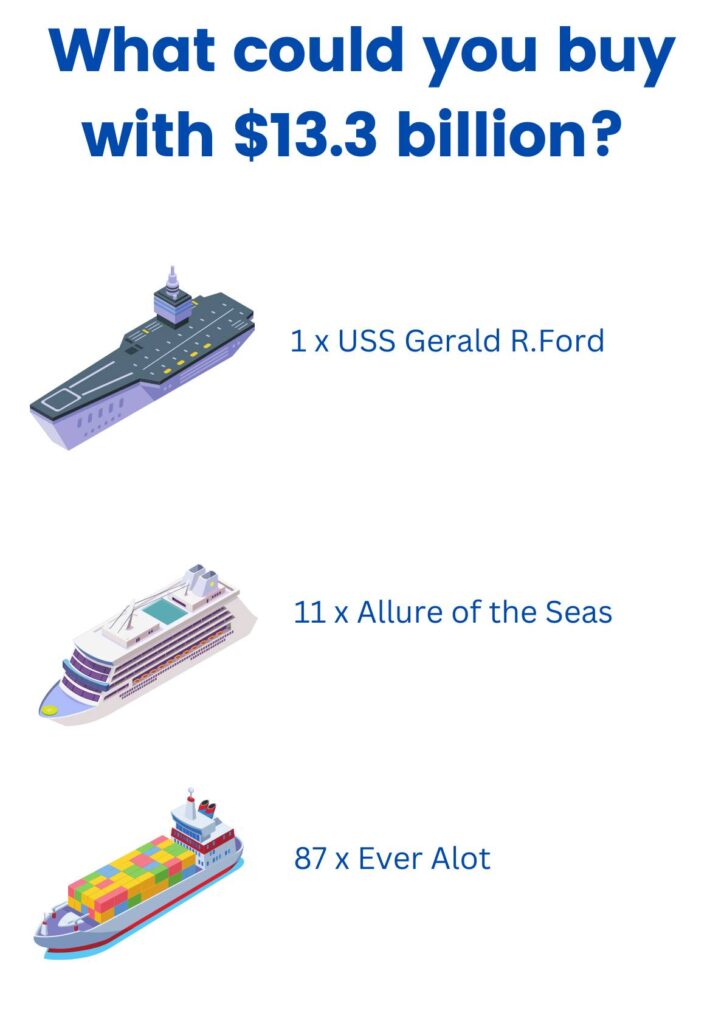
Capable of travelling at over 30 knots, USS Gerald R. Ford is much faster than the largest container ships and cruise ships.
She can carry 4,539 personnel when sailing with a full air wing, and has something very special that Ever Alot and Allure of the Seas do not – her very own onboard nuclear power plant .

This onboard nuclear power plant means that USS Gerald R. Ford will be able to sail for an incredible 20-25 years before she has to stop to refuel.
Modern container ships can be expected to have a maximum working life of around 20-25 years. Given that USS Gerald R. Ford has replaced USS Enterprise , which served for 51 years, it is safe to say that the aircraft carrier should still be sailing for many years after today’s biggest cargo and cruise ships have been scrapped.
Why don’t they make aircraft carriers bigger?
In order for cargo ships and cruise ships to be deemed a success, they have to make a profit over their lifetime. After all, they are run as a business.
The desire of shipping companies to maximise cargo and/or passengers carried, along with the savings that can be made with regards to crew, maintenance, and fuel costs from having fewer but larger ships, has led to increasingly larger ships being built.
Aircraft carriers are not designed to make money. In fact, in commissioning a new aircraft carrier, a country’s government is resigning itself to spending billions of dollars that it will never see again.
Aircraft carriers are built to sizes which make sense for their operational purpose. They are built for combat survivability, speed, range, and endurance.
The United States’ newest fleet of carriers will be the biggest warships ever built. The fact that they are not as large as some cargo ships does not mean that warships are not significantly bigger than they used to be – there just isn’t much to be gained from spending extra billions to make them any bigger – for now.
I've been on 2 ultra-luxury cruise ships — endless caviar and free flights make the $685 per day worth it
- The cruise industry's new ultra-luxury ships could be worth the expensive fares.
- Wealthy cruisers get high-end amenities like complimentary flights, caviar, and wine.
- Luxury small-ship cruising has becoming increasingly popular.

Say goodbye to questionable lunch buffets and tiny, windowless cabins. On ultra-luxury cruises , travelers get mountains of caviar, roundtrip business-class flights, and floating Rolex stores.
When you think of a cruise, you might picture the giant ships run by companies like Royal Caribbean and Norwegian. On these family-friendly floating resorts, activities like go-kart tracks, waterparks, and virtual reality arcades are commonplace.
On smaller, more expensive cruises, these large and loud amenities are replaced with peace, quiet, and foie gras.
Cruises are generally considered an affordable vacation option, with necessities like food and a cabin included in the base fare.
However, many mass-market cruise companies are increasingly following the budget airline model : Charge a cheap fare and pile up plenty of irresistible pay-to-play amenities.
Travelers could easily accidentally blow past their budget by the end of the vacation.
But guests luxuriate on high-end cruises, many of which are all-inclusive and don't have this problem.
Sure, luxury cruises have a higher base fare. But you'll never have to reach for your wallet once on board.
That's about as stress-free as you can get with a vacation.
"I'd rather have a few empty beds and get the right guests at the right price," Michael Ungerer, CEO of MSC Group's new luxury cruise line , Explora Journeys, told Business Insider in 2023. "Most of [the amenities] are already included, so we don't have to upsell."
After going on two luxury cruise ships, I now understand why so many wealthy travelers are splurging on these vacations at sea.
In 2023, I spent one night on Explora Journeys' Explora I while it was docked in New York and three nights on Regent Seven Seas Cruises' Grandeur while it sailed roundtrip from Miami. Both were complimentary non-revenue events for travel agents and media.
Seven Seas Grandeur's least expensive 2024 cruise is a seven-night roundtrip Miami voyage in December, starting at $4,800 per person — about $685 per day. (Travelers can book their own flights and pre-cruise hotels for a discounted fare.)
Meanwhile, Explora I's most affordable itinerary is a $3,030-per-person, 10-night November sailing from Barcelona to Bridgetown, Barbados.
Expensive? Yes. But on a cruise, money buys happiness.
On both ships, the fare includes complimentary bottles of Champagne, WiFi, endless alcoholic beverages, and access to the spa.
With Regent Seven Seas, pre-cruise hotels, every on board restaurant, flights to and from the ship (business class if international), and most excursions are also included.
Ironically, a higher price means a smaller ship.
The 922-guest Explora I stands at 813 feet and 63,900 gross-tons. The 746-guest Seven Seas Grandeur is smaller at 735 feet-long and 55,000 gross-tons.
To compare, Royal Caribbean's most popular and the world's largest cruise ship, the 7,600-guest Icon of the Seas , is a casual 1,196 feet long and 248,663 gross tons.
We’ll likely never see Icon of the Seas’ waterslides and theme park amenities across Regent Seven Seas' or Explora’s fleet.
But small ships have two big benefits: exclusivity and the ability to fit in more desirable ports.
The Grandeur is scheduled to sail to destinations like Oranjestad, Aruba, and Castries, Saint Lucia, while Explora I is planned for Hawaii and Casablanca, Morocco.
Icon of the Seas is exclusively sailing in the Caribbean this year.
Luxury ships still have some traditional amenities like pools, restaurants, and bars — just with an upscale flair, of course.
Instead of arcades, Explora I and Seven Seas Grandeur have cigar lounges.
Instead of a kid's playground, the latter has a quiet library.
Even the drinking water is better: No need to travel to Erewhon to sip on crystal-infused water. Just head to Explora I's spa instead.
The devil (quiet references to quiet luxury) is in the ships’ details.
Explora I has the first Rolex store at sea. The Cartier boutique is right next door.
Up a few decks, travelers can workout at the Technogym Artis Line-supplied gym, where a treadmill costs $20,250 and an elliptical $15,500.
Meanwhile, Seven Seas Grandeur is decorated with 503 chandeliers and a $6 million art collection that includes several original Pablo Picasso pieces and a custom Fabergé egg.
As expected, the food on these luxury ships are comparable to Michelin-starred restaurants.
Both floating five-star resorts have lunch buffets of raw seafood, lobster tails, and crab legs.
For dinner on the Explora I, travelers can dine on the six restaurants' wagyu tataki, grilled octopus, and aged prime rib with potatoes and caviar.
The Seven Seas Grandeur's five restaurants all serve some form of black truffle, sturgeon caviar, or foie gras.
For a 10-night cruise, Regent Seven Seas says its new ship carries 1,200 pounds of lobster, 20 pounds of caviar, and 5,000 bottles of wine — the most pricey at $2,500.
Expensive food means expensive service: Like many high-end on-land restaurants, the hostess always offered me a black napkin when I wore dark pants.
Dinners of steak tartare, lobster, and wine were as commonplace as the scrambled eggs at the breakfast buffet.
And, they're free, according to the laws of " girl math ."
By the end of my second night on the Regent Seven Seas ship, "I'm tired of eating caviar" went from being a joke to a serious statement.
If we're stereotyping, cruise ship bars can be less-than-luxe.
But don't call Explora I's Lobby Bar, which looks like it came out of an actual hotel bar, "trashy." After all, its background music comes from the overhead Steinway piano.
Starbucks outposts are becoming increasingly popular on mass-market ships.
But wealthy cruisers don't get to wake up with green siren-decorated cups of caffeine.
Instead, Explora I and Seven Seas Grandeur have their own coffee shops serving delectable espresso-based drinks and a separate afternoon tea service.
Like the lack of mediocre coffee, travelers on these fine ships will never be stuck in a tiny windowless interior cabin.
The smallest stateroom on the 461-cabin Explora I starts at 377 square-feet and flexes high-end amenities like a Dyson hairdryer.
The 373 cabins on the Seven Seas Grandeur start a bit smaller at 307 square-feet. At least it comes with L'Occitane en Provence products.
Both options have walk-in closets, floor-to-ceiling windows, and balconies. That's unheard of in the cheapest cabin on most mega-ships.
But one of the most pleasant differences between ultra-luxury and mid-tier cruises isn't in the amenities or dining.
It's the general ambiance.
Ultra-luxury ships aren't designed for cruising families with young children . The two ships didn't have cartoonish decor, loud lounges, or an unbearable number of children that could've kicked my fight-or-flight response.
Instead, the high-end vessels' common spaces were modern, mature, and relaxing.
If it seems like everyone you know has recently booked a cruise, you’d be correct.
Popular cruise lines like Royal Caribbean, Norwegian, and Carnival have recently seen off-the-charts bookings.
The same applies to the industry's more niche and expensive peers — especially as travelers have increasingly splurged on luxurious vacations like small-ship cruising.
In February, Harry Sommer, president and CEO of Regent's parent company, Norwegian Cruise Line Holdings , said demand for its luxury brands has been "very high."
After eating caviar and black truffles for every dinner on the Grandeur, I now understand why.
- Main content
- Carnival Cruise News
- Royal Caribbean News
- Disney Cruise News
- Travel News
- Casino News
- Cruise News
Check out Aircraft Carrier vs Cruise Ship: Giant Size Comparison

People have always been fascinated by gigantic ships. From history’s largest battleships to iconic passenger vessels, like the RMS Titanic , nothing captures the imagination quite like a sea-faring giant. That’s why we’re stacking up an aircraft carrier vs cruise ship and seeing how these vessels roam our seas.
Although they serve entirely different purposes, these two ships stand out as some of the largest and most intriguing. This guide will take a deep dive into comparing aircraft carriers and modern cruise ships so you can discover that they can actually be roughly the same size!
We’ll even explore how the world’s current largest aircraft carrier, the Gerald R. Ford Class Aircraft Carrier, is only 92 feet shorter than the largest cruise ship, Royal Caribbean’s Icon of the Seas .
Beyond offering a detailed size comparison, this comprehensive guide will also uncover differences in the purposes, maneuverability, and environmental impacts of these two types of ships.
So, if you’re ready to learn more about these ocean giants, let’s get started!
The average gross tonnage of a cruise ship is 150,000, along with an average length of 1,100 feet and 180 feet high. A typical aircraft carrier would be at 97,000 tons, 1,000 feet in length and 242 feet high. An aircraft carrier can often be much larger than a medium-sized cruise ship.

The concept of an aircraft carrier was first thought up during the First World War, as air power had demonstrated its significance in warfare. While early aircraft-carrying vessels developed by the British Royal Navy during this time failed to impress, these early aircraft carriers laid the foundations for the development of today’s enormous floating runway ships.
By the Second World War, the aircraft carrier had emerged as an essential weapon in naval warfare. Even outside of war, they serve as a stark projection of a nation’s military might. With missions ranging from combat to humanitarian assistance and disaster relief, today’s enormous and cutting-edge aircraft carriers hardly resemble the humble carriers of the early 20th century, like the HMS Furious .
Like aircraft carriers, cruise ships emerged in the early 20th century. While luxury ocean liners and ferries already existed, their primary purpose was transportation. The concept of a large-scale passenger ship explicitly designed for leisure and pleasure cruising was pretty new.
The first modern cruise ship, the Prinzessin Victoria Luise, was launched in 1900 , and it featured luxury accommodations and amenities, as well as leisurely voyages to exotic locations.
Today, cruise ships have grown in size and complexity to the point that they have almost evolved into floating resorts. By the 1960s, a growing tourism market meant the idea of relaxing on a luxury cruise ship had fully entered popular culture. Today, the cruise industry generates over $150 billion in economic activity and involves numerous cruise lines.
As mentioned, cruise ships and aircraft carriers may serve completely different roles and have distinct backgrounds, but they are fairly similar in physical size. To illustrate this point, we have provided a simple chart that compares the world’s largest cruise ship and the world’s largest aircraft carrier, as well as more general size comparisons of average vessels in each class:
Metric Average Aircraft Carrier USS Gerald R. Ford-class Average Cruise Ship Icon of the Seas LengthUSS Gerald R. Ford-class1,106 feet1,100 feet1,198 feetWidth180 feet257 feet125 feet225.5 feetDepth / Height242 feet250 feet180 feet198 feetWeight / Gross Tonnage97,000102,000150,000248,663
As you can see from a comparison of the current record holders for size, cruise ships tend to be longer than aircraft carriers, while the latter tends to be wider. An aircraft carrier’s added width and depth is due to accommodate and store aircraft. Due to tailhook technology, aircraft carriers do not need overly long flight decks , but the width helps with emergency landings and organizing aircraft before takeoff.
On the other hand, cruise ships are far denser, which explains the added weight. Since their many decks are packed with passenger cabins and suites, heavy amenities like swimming pools and restaurants, and so much more, their gross tonnage can be substantial. Plus, their added length, which helps them fit more into a streamlined ship, also contributes to their weight.
Simply put, aircraft carriers tend to be wider and taller than cruise ships, but cruise ships are usually heavier and longer.
Given that both types of ships are incredibly large and complex, it is no surprise that construction takes years. The following is a basic breakdown of the differences in the processes:
Construction typically takes between two and three years. The design and planning phase involves a collaboration between the cruise lines, naval architects, and shipyard engineers. Conceptualizing the ship’s specifications, layout, and types of amenities it will be outfitted with is an incredibly complex process.
Read Also: How Long Does It Take to Build a Cruise Ship?
Once a design has been finalized, the hull is assembled using enormous prefabricated steel plates. This occurs in a dry dock. From there, the ship’s interior can be outfitted with everything from passenger cabins to restaurants and recreational facilities. The vessel must also have the latest navigational systems, massive propulsion systems, fuel tanks, and a heavy cruise ship anchor.
Unlike cargo ships and other less complex vessels, the ships also need reliable HVAC systems for customer comfort and large-scale electrical systems capable of handling the ship’s immense power demands.
Once everything has been installed and the ship is fully furnished, rigorous sea trials are conducted to test the ship’s performance, safety, and compliance with maritime regulations .
While cruise ships vary in cost according to their size and what amenities are included in their design, most cost just shy of $1 billion to build. With that said, the world’s largest and most expensive cruise ship, the Icon of the Seas, cost Royal Caribbean International an estimated $2 billion!
Due to their complexity, aircraft carriers take longer to build. For most, the entire process spans 5 to 7 years, with each ship having unique demands according to its operational requirements.
Not only do these ships need to be outfitted with incredibly complex systems, but the entire process involves a shroud of secrecy, as these ships are incredibly valuable pieces of military hardware.
The process starts with the laying of the keel. From there, the high-strength steel alloy hull is attached. The hulls must be capable of withstanding the hardships of ocean travel and extreme weather, and they also need to be engineered to withstand the demands of a potential combat situation.
Once the outer structure of the ship has been completed, a vast array of complex systems, like aircraft elevators, recovery systems, firefighting systems, defensive armaments, and navigation equipment, must be installed and tested. On top of that, the enormous flight decks that are such an iconic feature of an aircraft carrier also have to be built.
The same is true for the internal hangars for the various types of aircraft the ship will carry, crew quarters, and the countless other needs of a ship that needs to be ready for both aerial and naval combat.
On top of all that, modern aircraft carriers are even powered by nuclear reactors , so they can stay operational indefinitely. As you can imagine, building a nuclear-powered ship is incredibly time-consuming and demanding. Finally, before the ship can be deemed ready for service, it must be thoroughly tested.
Unsurprisingly, all of this complexity comes with an eye-watering price tag. Most of the latest classes of aircraft carriers, like the Nimitz-Class carriers operated by the United States, cost over $6 billion to build.
As we discussed earlier, the two types of vessels serve entirely different purposes. Where an aircraft carrier’s main job is to be a significant source of naval power by being able to act as a floating airfield and mobile base, cruise ships are designed with the passenger experience as the top priority.
While aircraft carriers can certainly act as hugely significant weapons of war and as combat command centers, they also work as war deterrents. Demonstrating a nation’s naval and air superiority in the world’s most highly contested waters discourages hostile nations from attacking others. They can also serve a valuable purpose during humanitarian missions by delivering aid and evacuation aircraft worldwide.
On the other hand, cruise ships enable passengers to experience the adventure and relaxation of a floating paradise that can travel to the most incredible destinations. While they have many of the same features that make a resort vacation so enjoyable, they are mobile, so passengers can visit ports around the world and take in the natural beauty of the world’s coastlines, oceans, and seas.
Cruise ship facilities and amenities differ according to the specific design of the ship, but most feature numerous restaurants and bars, theaters for live performances and entertainment, casinos, swimming pools and water parks, lounge decks, spas, gyms, and more.
Cruise ships have a wide range of comfortable facilities, entertaining amenities, and luxury accommodations, so their guests can enjoy the unique blend of adventure, fun, and relaxation that is unique to the cruise industry.
Aircraft carriers feature a wide array of offensive and defensive systems and all the facilities required to house their enormous crews. They must also function as floating runways for military aircraft, including fighter jets and helicopters.
On top of military systems and hardware, like missile defense systems, these floating bases also need medical bays, crew quarters, mess halls, gyms, laundry facilities, and storage areas. Think of an aircraft carrier as a mixture of a floating military base, an air force airfield, and a naval vessel.
Aircraft carriers usually carry a complement of over 5,000 individuals. This number includes sailors, naval officers, pilots, and countless support personnel responsible for maintaining the ship and the complex systems and aircraft it carries. On top of that, you have engineers, navigators, doctors, cooks, and more.
On the other hand, the passenger capacity of cruise ships sits at an average of about 3,000 passengers. The average ship will also travel with a crew of nearly 1,000 people. That said, the number can fluctuate depending on the size of the ship. Take, for example, the Icon of the Seas , which was designed to hold 5,610 passengers and a crew of 2,350 .
Modern aircraft carriers are powered by nuclear reactors that can propel their powerful engines at a speed exceeding 30 knots (roughly 55.5 km per hour). On top of that, these enormous ships are also incredibly agile, as they need to be able to pivot direction and respond quickly to threats and new orders.
On the other hand, cruise ships rely on diesel-electric propulsion systems. A cruise ship’s top speed is generally 18 to 22 knots . Since these vessels were designed for passenger comfort rather than military action and rapid transit, they move at a slower and more consistent pace.
Their propulsion systems are also designed to maximize fuel efficiency, as this reduces operating costs, environmental impact, and the amount of diesel fuel they need to carry.
Since aircraft carriers use nuclear reactors that generate steam to drive their turbines, they emit less emissions than you get with fossil fuel-powered ships. Although reducing greenhouse emissions was not the intention, it is a major plus, given these huge ships travel enormous distances and stay at sea for months at a time.
On the other hand, the diesel engines used by cruise ships need to burn a significant amount of fuel as a power source for their propulsion and electrical systems. This does contribute heavily to air pollution, but the cruise industry is working to improve its environmental image by introducing more fuel-efficient ships, and other tactics, like using onboard waste reduction and recycling systems.
Since aircraft carriers are military vessels, they face extreme security challenges. Defensive systems, like anti-aircraft missiles and close-in weapons gun systems , help protect the ship from aerial threats. Sprinkler systems and firefighting crews also help reduce the threat of fires.
Traditional safety measures are also used to protect the crew, including adequate lifeboats for all personnel and incredibly complex navigation and communications systems.
Worth Reading: What to Expect During a Cruise Ship Muster Drill
Cruise ships are outfitted with fire suppression systems, CCTV systems, complex weather detection and communications systems, and lifeboats to keep their guests and crew safe. Plus, the entire crew and security staff are trained to follow the safety procedures needed to keep everyone safe in any situation.
When it comes to aircraft carrier vs cruise ship, both types of ships traverse waters around the world, but aircraft carriers tend to prioritize strategic choke points and high-traffic waterways. This allows them to contribute to global stability and react to various situations around the globe.
On the other hand, cruise ships usually have itineraries that take them to areas with a booming tourism sector, like the Caribbean and Mediterranean, as well as places with picturesque natural beauty, like Alaska. With that said, cruise lines are operating all over the world, each offering unique itineraries that visit exciting destinations and offer memorable excursions.
As the world’s largest ships, typical oil tankers tend to be bigger than aircraft carriers in terms of length and width. They also weigh more, especially when fully loaded with their liquid cargo. Take, for example, the largest ship ever built, a super oil tanker called the Seawise Giant. It measured over 1,500 feet in length!
Which is bigger, a container ship or an aircraft carrier?
A container ship is usually bigger than an aircraft carrier, as they are built to be as large as possible to carry cargo across the world’s oceans and largest seas.
Aircraft carriers are one of the most important symbols of power and tools of military might in a nation’s arsenal. These mobile air bases can react to threats worldwide while safeguarding the world’s oceans.
Do you want to see more? click on the link
RELATED ARTICLES MORE FROM AUTHOR
Take a look at Cruise Ship Held in Barcelona Due to Improper Visas
See how Cruise Ship Encounters Red Sea Tensions on Repositioning Voyage
Take a look at Holland America Line Changes Itinerary for Upcoming Grand Voyage
Leave a reply cancel reply.
Save my name, email, and website in this browser for the next time I comment.

Don't Miss
Check out carnival cruise line’s black friday cruise deals are now live, save..., take a look at 7 hottest new cruise ships debuting in 2024, take a look at embarkation delayed for carnival cruise line flagship, take a look at princess cruise ship delayed for disinfection, even more news.
See how Cruise Ship Encounters Red Sea Tensions on Repositioning...
Take a look at Cruise Ship Held in Barcelona Due to...
Check out Royal Caribbean Delays Cruise Despite Earlier Assurances
Popular category.
- Cruise News 1941
- Disney Cruise News 216
- Carnival Cruise News 74
- Royal Caribbean News 64
- Casino News 57
- Travel News 33
- Visit our Youtube page!
- International

Israel-Hamas war

Taiwan quake
March 27, 2024 - Baltimore Key Bridge collapse
By Kathleen Magramo , Antoinette Radford, Alisha Ebrahimji , Maureen Chowdhury , Elise Hammond , Tori B. Powell and Aditi Sangal , CNN
Our live coverage of the Baltimore bridge collapse has moved here .
Here's what you should know about the Key Bridge collapse
From CNN staff

Officials recovered the bodies of two construction workers who were on Baltimore's Francis Scott Key Bridge when it collapsed early Tuesday morning after a 984-foot-long cargo ship collided into a pillar.
Maryland Gov. Wes Moore called the collapse Wednesday " a global crisis ."
"The national economy and the world's economy depends on the Port of Baltimore. The port handles more cars and more farm equipment than any other port in the country," Moore said.
Here's what you should know:
- The victims: The six people who are presumed dead were from Mexico Guatemala, El Salvador and Honduras, according to Col. Roland L. Butler Jr, the superintendent of Maryland State Police. Two bodies were recovered and have been identified as Alejandro Hernandez Fuentes from Mexico and Dorlian Ronial Castillo Cabrera from Guatemala. The two workers were filling potholes on the bridge and were later found trapped in a red pickup truck in about 25 feet of water, Butler said. The FBI is handling notifying the victims' families, Butler said.
- Recovery efforts: Authorities are pausing search efforts for the four other workers who are presumed dead, because additional vehicles are encased in concrete and other debris, making it unsafe for divers, Butler said. Once salvage operations clear the debris, divers will search for more remains, he said.
- The investigation: The National Transportation Safety Board is leading the investigation into the fatal incident, according to the agency's chair Jennifer Homendy. During a Wednesday news conference, Homendy said there were 21 crew members and two pilots on board the Dali cargo ship when it crashed into the bridge. She also said a senior NTSB hazmat investigator identified 56 containers of hazardous material, and that some containers are in the water. The agency received six hours of voyage data from the ship and the investigation could take 12 to 24 months to complete, Homendy said. She emphasized that NTSB will not analyze information collected or provide conclusions while on scene of the collapse.
- Looking forward: Department of Transportation Secretary Pete Buttigieg said rebuilding the bridge will not be "quick or easy" but that it will get done. He said there are four main focus points ahead: reopening the port, dealing with supply chain issues until its reopening, rebuilding the bridge and dealing with traffic issues until the bridge is rebuilt. Biden pledged the full support of the federal government in the response and recovery efforts. His administration has already conveyed a sense of urgency to open up federal funding to remove debris and ultimately rebuild the bridge. Maryland has submitted a request to the Biden administration for emergency relief funds "to assist in our work going forward," Moore said Wednesday.
It's almost impossible to place people on the bow of ship due to the unstable structure, fire official says
From CNN's Sarah Engel
Baltimore City Fire Chief James Wallace said Wednesday that the cargo ship's bridge structure and containers at the bow remain unstable.
"It's going to be very difficult, if not impossible, and very dangerous, to place people on the bow of that boat right now," Wallace told CNN's Kaitlan Collins.
"Naturally, we're still very cognizant of the fact that there are hazardous materials on board the vessel itself," Wallace said, alluding to the National Transportation Safety Board saying earlier that 56 containers were carrying hazardous materials.
Wallace said his team is relying heavily on aerial recognizance, including drones. "That's the only way we're able to see in," he said.
He added that the aerial surveillance has "been able to really assure us right now we have no [chemical] reactions on board."
"It's just utter devastation," NTSB chief says of the bridge collapse site
From CNN's Aditi Sangal
Jennifer Homendy, chair of the National Transportation Safety Board, called the site of the Key Bridge collapse "devastating."
"It's pretty devastating, certainly, seeing not just what's going on with the cargo containers, but just looking at what was a bridge span — three bridge spans that is pretty much gone. It's just utter devastation," she said at Wednesday evening's news briefing.
She added that she is thinking of families who lost loved ones and those who are waiting to reunite with their lived ones.
NTSB interviewed the Dali's captain and some other crew members today, agency chief says
The National Transportation Safety Board has interviewed the ship's captain, his mate, the chief engineer and one other engineer today, according to Chair Jennifer Homendy.
The two pilots on board the Dali at the time of collision will be interviewed tomorrow, she added.
Cargo ship's voyage data recorder is basic when compared to an airplane's, NTSB chair says
From CNN's Tori B. Powell
The voyage data recorder on the cargo ship Dali was a "newer model" but is considered basic when compared to that on an airplane, according to National Transportation Safety Board Chair Jennifer Homendy.
"But it is very basic compared to say, a flight data recorder, where we would have 1,000 parameters," she said at a news conference on Wednesday.
The NTSB chief investigator Marcel Muise added:
"It's not a ship-wide system recorder, so most of the sensors that are being recorded are from the bridge. So things like GPS, the audio, rudder feedback, rudder commands are recorded on there. But not engineering, the temperature of each cylinder, power distribution sensors."
There were no tug boats with Dali at the time of the collision. That's normal, NTSB chief says

There were no tugs with Dali when the cargo vessel collided with Baltimore's Key Bridge, which is normal protocol, according to National Transportation Safety Board Chair Jennifer Homendy.
Remember: At 01:26:39 on Tuesday, Dali's pilot made a general very high frequency (VHF) radio call for tugs in the vicinity to assist, the NTSB investigator Marcel Muise had said.
"The tugs help the vessel leave the dock, leave the port and get into the main ship channel. And then they leave. Once it's on its way, it's a straight shot through the channel. So there are no tugs with the vessel at the time. So they were calling for tugs," she said.
NTSB chair says she saw some containers that were carrying hazardous materials in the water
National Transportation Safety Board Chair Jennifer Homendy said she did see some of the 56 containers that were carrying hazardous materials in the water.
When asked how many
When asked how many containers of hazardous materials were in the water, Homendy said:
"I did see some containers in the water, and some breached significantly on the vessel itself," she said. "I don't have an exact number, but it's something that we can provide in an update."
Homendy said that a preliminary report should be out in two to four weeks.
This post has been updated with more quotes from Homendy.
Bridge did not have any redundancy, unlike the preferred method for building bridges today, NTSB chair says
Baltimore's Key Bridge did not have any redundancy, which is included in the preferred method of building bridges in the present day, according to National Transportation Safety Board Chair Jennifer Homendy.
"The bridge is a fracture critical," she explained. "What that means is if a member fails that would likely cause a portion of, or the entire bridge, to collapse, there's no redundancy. The preferred method for building bridges today is that there is redundancy built in, whether that's transmitting loads to another member or some sort of structural redundancy. This bridge did not have redundancy," Homendy said.
There are 17,468 fracture critical bridges in the United States out of 615,000 bridges total, she said, citing the Federal Highway Administration.
Please enable JavaScript for a better experience.

Is a Cruise Ship Bigger Than an Aircraft Carrier?
By Robert Palmer
When it comes to size, it can be difficult to compare a cruise ship with an aircraft carrier. While both types of vessels are large and impressive, they have different functions and serve different purposes. This article will attempt to answer the question of whether a cruise ship is bigger than an aircraft carrier or not.
Aircraft carriers are some of the largest ships ever built. The USS Gerald R. Ford class aircraft carriers are the largest ever constructed, measuring 1,106 feet in length and weighing more than 100,000 tons. These enormous vessels are designed for launching and recovering military aircraft and can carry up to 90 aircraft.
Cruise ships, on the other hand, are much less massive than aircraft carriers. The world’s largest cruise ship is Royal Caribbean’s Symphony of the Seas, which measures 1,188 feet in length and weighs 228,000 tons. Cruise ships usually carry between 2,000-4,000 passengers plus crew members.
Conclusion:
In conclusion, it is clear that an aircraft carrier is smaller than a cruise ship when it comes to size. An aircraft carrier typically measures around 1,100 feet in length while a cruise ship can measure up to 1,188 feet in length – making the cruise ship greater in size than an aircraft carrier.
9 Related Question Answers Found
Is a cruise ship bigger than a cargo ship, is a cruise ship bigger than a battleship, is a cruise ship bigger than a whale, is a cruise ship bigger than the titanic, is a cruise ship bigger than a blue whale, is cruise ship bigger than blue whale, is a cruise ship bigger than the ark, is a aircraft carrier bigger than a cruise ship, is a modern day cruise ship bigger than the titanic, backpacking - budget travel - business travel - cruise ship - vacation - tourism - resort - cruise - road trip - destination wedding - tourist destination - best places, london - madrid - paris - prague - dubai - barcelona - rome.
© 2024 LuxuryTraveldiva
Six presumed dead after cargo ship crash levels Baltimore bridge
BALTIMORE — A major Baltimore bridge collapsed like a house of cards early Tuesday after it was struck by a container ship, sending six people to their deaths in the dark waters below, and closing one of the country’s busiest ports.
By nightfall, the desperate search for six people who were working on the bridge and vanished when it fell apart had become a grim search for bodies.
“We do not believe that we’re going to find any of these individuals still alive,” Coast Guard Rear Admiral Shannon N. Gilreath said.
Jeffrey Pritzker, executive vice president of Brawner Builders, said earlier that one of his workers had survived. He did not release their names.
Up until then, Maryland Gov. Wes Moore had held out hope that the missing people might be found even as law enforcement warned that the frigid water and the fact that there had been no sign of them since 1:30 a.m. when the ship struck Francis Scott Key Bridge.
Moore expressed heartbreak after officials suspended the search for survivors.
"Our heart goes out to the families," he said. "I can’t imagine how painful today has been for these families, how painful these hours have been have been for these families."
It was a crushing blow to the loved ones of the missing men, who had waited for hours at a Royal Farms convenience store near the entrance of the bridge for word of their fate.
Follow live updates on the Baltimore bridge collapse
The tragic chain of events began early Tuesday when the cargo ship Dali notified authorities that it had lost power and issued a mayday moments before the 984-foot vessel slammed into a bridge support at a speed of 8 knots, which is about 9 mph.
Moore declared a state of emergency while rescue crews using sonar detected at least five vehicles in the frigid 50-foot-deep water: three passenger cars, a cement truck and another vehicle of some kind. Authorities do not believe anyone was inside the vehicles.
Investigators quickly concluded that it was an accident and not an act of terrorism.
Ship was involved in another collision
Earlier, two people were rescued from the water, Baltimore Fire Chief James Wallace said. One was in good condition and refused treatment, he said. The other was seriously injured and was being treated in a trauma center.
Moore said other drivers might have been in the water had it not been for those who, upon hearing the mayday, blocked off the bridge and kept other vehicles from crossing.
“These people are heroes,” Moore said. “They saved lives.”
Nearly eight years ago, the Dali was involved in an accident. In July 2016, it struck a quay at the Port of Antwerp-Bruges in Belgium, damaging the quay.
The nautical commission investigated the accident, but the details of the inquiry were not immediately clear Tuesday.
The Dali is operated and managed by Synergy Group. In a statement, the company said that two port pilots were at the helm during Tuesday's crash and that all 22 crew members onboard were accounted for.
The Dali was chartered by the Danish shipping giant Maersk, which said it would have no choice but to send its ships to other nearby ports with the Port of Baltimore closed.
The bridge, which is about a mile and a half long and carries Interstate 695 over the Patapsco River southeast of Baltimore, was "fully up to code," Moore said.
National Transportation Safety Board Chairwoman Jennifer Homendy said that her agency will lead the investigation and that a data recorder on the ship could provide more information.
"But right now we're focusing on the people, on the families," she said. "The rest can wait."
President Joe Biden vowed to rebuild the bridge and send federal funds.
"This is going to take some time," the president warned. "The people of Baltimore can count on us though to stick with them, at every step of the way, till the port is reopened and the bridge is rebuilt."
Speaking in Baltimore, Transportation Secretary Pete Buttigieg echoed the president's promise.
"This is no ordinary bridge," he said. "This is one of the cathedrals of American infrastructure."
But Buttigieg warned that replacing the bridge and reopening the port will take time and money and that it could affect supply chains.
The Port of Baltimore, the 11th largest in the U.S., is the busiest port for car imports and exports, handling more than 750,000 vehicles in 2023 alone, according to data from the Maryland Port Administration.
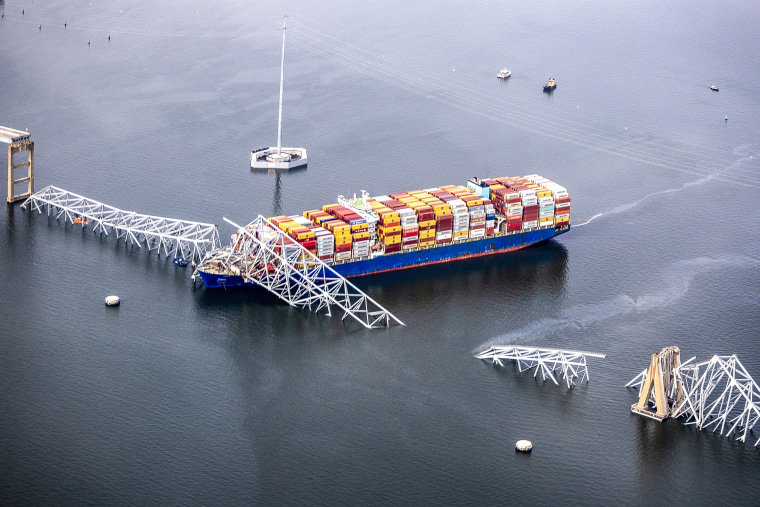
Writer David Simon, a champion of Baltimore who set his TV crime drama "The Wire" on the streets of the city he once covered as a reporter, warned online that the people who will suffer the most are those whose livelihoods depend on the port.
"Thinking first of the people on the bridge," Simon posted on X . "But the mind wanders to a port city strangling. All the people who rely on ships in and out."
Timeline of crash
Dramatic video captured the moment at 1:28 a.m. Tuesday when the Dali struck a support and sent the bridge tumbling into the water. A livestream showed cars and trucks on the bridge just before the strike. The ship did not sink, and its lights remained on.
Investigators said in a timeline that the Dali's lights suddenly shut off four minutes earlier before they came back on and that then, at 1:25 a.m. dark black smoke began billowing from the ship's chimney.
A minute later, at 1:26 a.m., the ship appeared to turn. And in the minutes before it slammed into the support, the lights flickered again.
Maryland Transportation Secretary Paul Wiedefeld said the workers on the bridge were repairing concrete ducts when the ship crashed into the structure.
At least seven workers were pouring concrete to fix potholes on the roadway on the bridge directly above where the ship hit, said James Krutzfeldt, a foreman.
Earlier, the Coast Guard said it had received a report that a “motor vessel made impact with the bridge” and confirmed it was the Dali, a containership sailing under a Singaporean flag that was heading for Sri Lanka.
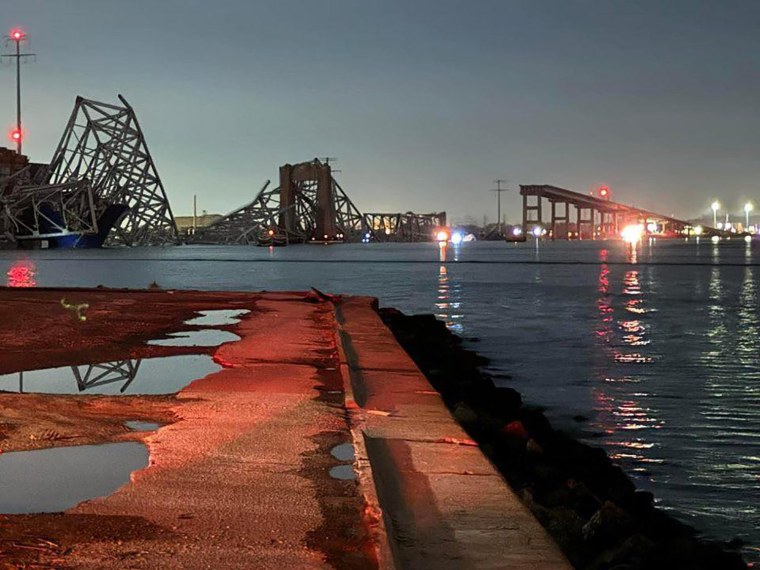
Bobby Haines, who lives in Dundalk in Baltimore County, said he felt the impact of the bridge collapse from his house nearby.
"I woke up at 1:30 this morning and my house shook, and I was freaking out," he said. "I thought it was an earthquake, and to find out it was a bridge is really, really scary."
Families of bridge workers wait for updates
Earlier in the day, relatives of the construction crew waited for updates on their loved ones.
Marian Del Carmen Castellon told Telemundo her husband, Miguel Luna, 49, was working on the bridge.
“They only tell us that we have to wait and that they can’t give us information,” she said.
Castellon said she was "devastated, devastated because our heart is broken, because we don’t know how they have been rescued yet. We are just waiting for the news."
Luna's co-worker Jesús Campos said he felt crushed, too.
“It hurts my heart to see what is happening. We are human beings, and they are my folks,” he said.
Campos told The Baltimore Banner that the missing men are from El Salvador, Guatemala, Honduras and Mexico.
Active search and rescue ends
The Coast Guard said it was suspending the active search-and-rescue effort at 7:30 p.m. Tuesday.
"Coast Guard’s not going away, none of our partners are going away, but we’re just going to transition into a different phase," Gilreath said at a news conference.
Maryland State Police Superintendent Roland L. Butler, Jr., said it was moving to a recovery operation. Changing conditions have made it dangerous for divers, he said.
Butler pledged to "do our very best to recover those six missing people," but the conditions are difficult.
"If we look at how challenging it is at a simple motor vehicle crash to extract an individual, I'm sure we can all imagine how much harder it is to do it in inclement weather, when it's cold, under the water, with very limited to no visibility," he said.
"There's a tremendous amount of debris in the water," which can include sharp metal and other hazards, and that could take time, Butler said.
'A long road in front of us'
Built in 1977 and referred to locally as the Key Bridge, the structure was later named after the author of the American national anthem.
The bridge is more than 8,500 feet long, or 1.6 miles. Its main section spans 1,200 feet, and it was one of the longest continuous truss bridges in the world upon its completion, according to the National Steel Bridge Alliance .
About 31,000 vehicles a day use the bridge, which equals 11.3 million vehicles per year, according to the Maryland Transportation Authority.
The river and the Port of Baltimore are both key to the shipping industry on the East Coast, generating more than $3.3 billion a year and directly employing more than 15,000 people.
Asked what people in Baltimore can expect going forward, the state's transportation secretary said it is too early to tell.
"Obviously we reached out to a number of engineering companies, so obviously we have a long road in front of us," Wiedefeld said.
Julia Jester reported from Baltimore, Patrick Smith from London, Corky Siemaszko from New York and Phil Helsel from Los Angeles.
Julia Jester is a producer for NBC News based in Washington, D.C.
Patrick Smith is a London-based editor and reporter for NBC News Digital.
Phil Helsel is a reporter for NBC News.
Corky Siemaszko is a senior reporter for NBC News Digital.

IMAGES
VIDEO
COMMENTS
How Does a Cruise Ship Compare to an Aircraft Carrier? The average gross tonnage of a cruise ship is 150,000, along with an average length of 1,100 feet and 180 feet high. A typical aircraft ...
A cruise ship is typically around 250 to 300 meters long. The world's largest cruise ship, Royal Caribbean's Symphony of the Seas, is a whopping 362 meters in length. An aircraft carrier, on the other hand, is much larger. The largest active aircraft carrier in the world today is the USS Gerald R Ford, which has a total length of 337 meters.
How Does a Cruise Ship Compare to an Aircraft Carrier? The average gross tonnage of a cruise ship is 150,000, along with an average length of 1,100 feet and 180 feet high. A typical aircraft carrier would be at 90,000 tonnes, 1,000 feet in length and 242 feet high. An aircraft carrier can often be much larger than a medium-sized cruise ship.
When sizing up the giants of the sea, it can be awe-inspiring to compare the behemoths that are aircraft carriers and the largest cruise ships. Each is a titan in its own right, serving very ...
When comparing the size of an aircraft carrier to that of a cruise ship, it's clear that an aircraft carrier is significantly larger than its civilian counterpart. Aircraft carriers are approximately 1000 feet long whereas cruise ships typically measure around 900 feet in length. Additionally, aircraft carriers weigh about 100,000 tons while ...
We shall contrast aircraft carriers with cruise ships in this article to examine the key differences between them in terms of size, function, construction, accommodations, power source, duty, and safety. Aircraft Carrier vs Cruise Ship Key Takeaways. Aircraft carriers and cruise ships are both large vessels, but serve vastly different purposes.
Aircraft Carriers: The average length of an aircraft carrier ranges from 600 to 1,100 feet (183-335 meters). The largest aircraft carrier ever built is the USS Gerald R. Ford, which measures 1,092 feet (333 meters) in length. Cruise Ships: Cruise ships come in various sizes but generally range from 800 to 1,200 feet (244-366 meters) in length.
When comparing cruise ships and aircraft carriers, it is evident that they are roughly the same length. The U.S. Navy's Gerald R. Ford holds the title of the largest aircraft carrier at sea, measuring 1,106 feet in length. In comparison, an average-sized cruise ship spans approximately 1,000 feet, which is akin to the length of three football ...
Passenger capacity is a good way to compare cruise ships. However, it's important to consider that there are two different measures of passenger capacity for a ship - double occupancy and maximum occupancy. ... Aircraft carriers and cruise ships are roughly the same size. The largest aircraft carrier at sea, the Gerald R Ford Class aircraft ...
Aircraft Carrier vs Cruise Ship Size Comparison • Generation Aerospace. When it comes to vessels that dominate the open seas, two titans stand out in their own right—the aircraft carrier and the cruise ship. While both are marvels.
The Royal Caribbean cruise liner Oasis of the Sea and the US aircraft carrier USS Gerald Ford. Weight and length are factors considered in this comparison. Both measure approximately 1200 feet in length. (Ford 1106, Oasis 1186) However, the Oasis of the Sea weighs 225,000 tons as opposed to Gerald Ford's about 100,000 tons.
Utopia of the Seas Beam (Maximum): 211 feet. Utopia of the Seas Passenger Capacity (Double/Max): 5,668/6,509. 3. Royal Caribbean Wonder of the Seas. Wonder of the Seas. Royal Caribbean's Wonder of ...
A cruise ship's top speed is 22-24 knots (41-44 km/h), but an aircraft carrier can typically go at 30-35 knots (55-65 km/h). Due to their different purposes, cruise ships prioritize luxury over speed, whereas aircraft carriers must be able to move swiftly to defend against potential attacks.
The Oasis was compared to the aircraft carrier often when it was under construction. The displacement is the best measure here to compare the mass of the two ships. That's how much pressure is put on the water by the ship. So the Nimitz aircraft carrier and Oasis weighs the same.
Aircraft carriers and cruise ships have a lot of similarities, but there is one major difference - size. An aircraft carrier is much bigger than a cruise ship, and it has to be in order to accommodate the size and weight of the aircraft it carries. Aircraft carriers are typically 1,000 feet long, or about three football fields in length.
In this episode, we compare the sizes of many ships from the Titanic to the Noah Ark, container ships to cruise ship to find out which is the largest. We eve...
Our Cruise Ship Comparison Tool will let you see the differences between two ships. We did all the research to make it easy for you. Look at the differences in size, number of guests, types of food, and various activities. We also help you compare how much is included so you know how much you might end up spending on board.
Comparing the world's largest aircraft carrier, cargo ship, and cruise ship. There is one figure in the above table that stands out - even the biggest cargo ships can be run fairly efficiently on between 20-30 crew. On cargo ships, merchant seafarers are trained to be multi-discipline experts, while the vast majority of the crew on cruise ...
To compare, Royal Caribbean's most popular and the world's largest cruise ship, the 7,600-guest Icon of the Seas, is a casual 1,196 feet long and 248,663 gross tons. Advertisement.
In the Russian Navy, "aviation cruiser" is a designation for the Kiev and Kuznetsov -class ships. They are a cross between a cruiser and an aircraft carrier. Aviation cruisers have close-in weapon systems, both gun and missile, for self-defense against missiles or rockets. Unlike aircraft carriers who rely solely upon their aircraft and ...
In comparison, an aircraft carrier is much larger than a cruise ship. The world's largest aircraft carrier is the U.S Navy's Gerald R Ford-class supercarrier which measures 101,000 tons in displacement and 1,092 feet in length. It also has a beam (width) of 134 feet and can carry up to 90 aircrafts along with 6,250 personnel including crew ...
People have always been fascinated by gigantic ships. From history's largest battleships to iconic passenger vessels, like the RMS Titanic, nothing captures the imagination quite like a sea-faring giant. That's why we're stacking up an aircraft carrier vs cruise ship and seeing how these vessels roam our seas. Although they serve entirely different purposes, these two […]
The voyage data recorder on the cargo ship Dali was a "newer model" but is considered basic when compared to that on an airplane, according to National Transportation Safety Board Chair Jennifer ...
Aircraft carriers and cruise ships have a lot of similarities, but there is one major difference - size. An aircraft carrier is much bigger than a cruise ship, and it has to be in order to accommodate the size and weight of the aircraft it carries. Aircraft carriers are typically 1,000 feet long, or about three football fields in length.
The tragic chain of events began early Tuesday when the cargo ship Dali notified authorities that it had lost power and issued a mayday moments before the 984-foot vessel slammed into a bridge ...